Forums
- Forums
- Duggy's Reference Hangar
- USAAF / USN Library
- Bell P-59 Airacomet
Bell P-59 Airacomet
Post a reply
- Go to Previous topic
- Go to Next topic
- Go to Welcome
- Go to Introduce Yourself
- Go to General Discussion
- Go to Screenshots, Images and Videos
- Go to Off topic
- Go to Works in Progress
- Go to Skinning Tips / Tutorials
- Go to Skin Requests
- Go to IJAAF Library
- Go to Luftwaffe Library
- Go to RAF Library
- Go to USAAF / USN Library
- Go to Misc Library
- Go to The Ops Room
- Go to Made in Germany
- Go to Campaigns and Missions
- Go to Works in Progress
- Go to Juri's Air-Raid Shelter
- Go to Campaigns and Missions
- Go to Works in Progress
- Go to Skinpacks
- Go to External Projects Discussion
- Go to Books & Resources
-
9 years agoSat Dec 30 2023, 10:38amDuggy
 Main AdminThe Bell XP-59A Airacomet was America's first jet aircraft. For that reason alone, the aircraft is of historic significance. Although it never fired a shot in anger during World War II, it was nevertheless important in that it provided a lot of important data on the care and maintenance of jet aircraft, which proved invaluable when more advanced jet fighters came in to service.
Main AdminThe Bell XP-59A Airacomet was America's first jet aircraft. For that reason alone, the aircraft is of historic significance. Although it never fired a shot in anger during World War II, it was nevertheless important in that it provided a lot of important data on the care and maintenance of jet aircraft, which proved invaluable when more advanced jet fighters came in to service.
The history of the Airacomet is one of the most interesting of any of the aircraft. But first, we must go back a bit and start with the Bell XP-52.
The Bell XP-52 was an unorthodox fighter project that arose out of a USAAC competition held in the winter of 1939 for a fighter that would be much more effective than any extant--with a top speed, rate of climb, maneuverability, armament, and pilot visibility, all of which would be far superior to those of any existing fighter. In addition, the fighter was required to have a low initial cost and had to be easy and inexpensive to maintain.
The USAAC issued its requirements to the industry in the form of Request for Data R-40C. No less than 50 responses came in. Among these was the Model 16, which the Bell company had developed some months earlier. Bell was famous for submitting unconventional designs, and the Model 16 was no exception. It had a round, barrel-shaped fuselage with the pilot seated in the nose and a 1250 hp Continental XIV-1430-5 liquid-cooled twelve-cylinder inverted vee engine mounted behind the pilot and driving a pair of contrarotating coaxial propellers operating in pusher fashion. The wing was mounted in mid-fuselage position, and was swept back at an angle of about 20 degrees. Twin booms were mounted about one-third of the way along the wings outboard of the fuselage. The horizontal tailplane at the rear connected the two booms. A tricycle landing gear was to be fitted, with the nosewheel retracting into the fuselage and the mainwheels retracting into the booms. Two 20-mm cannon were to be mounted in the lower fuselage, and three 0.50-in machine guns were to be mounted in the front of each of the twin booms.
One unusual feature of the Model 16 was the presence of an engine radiator cooing air intake mounted in the extreme nose. Nose-mounted air intakes were features which were later to be seen in jet-powered fighters.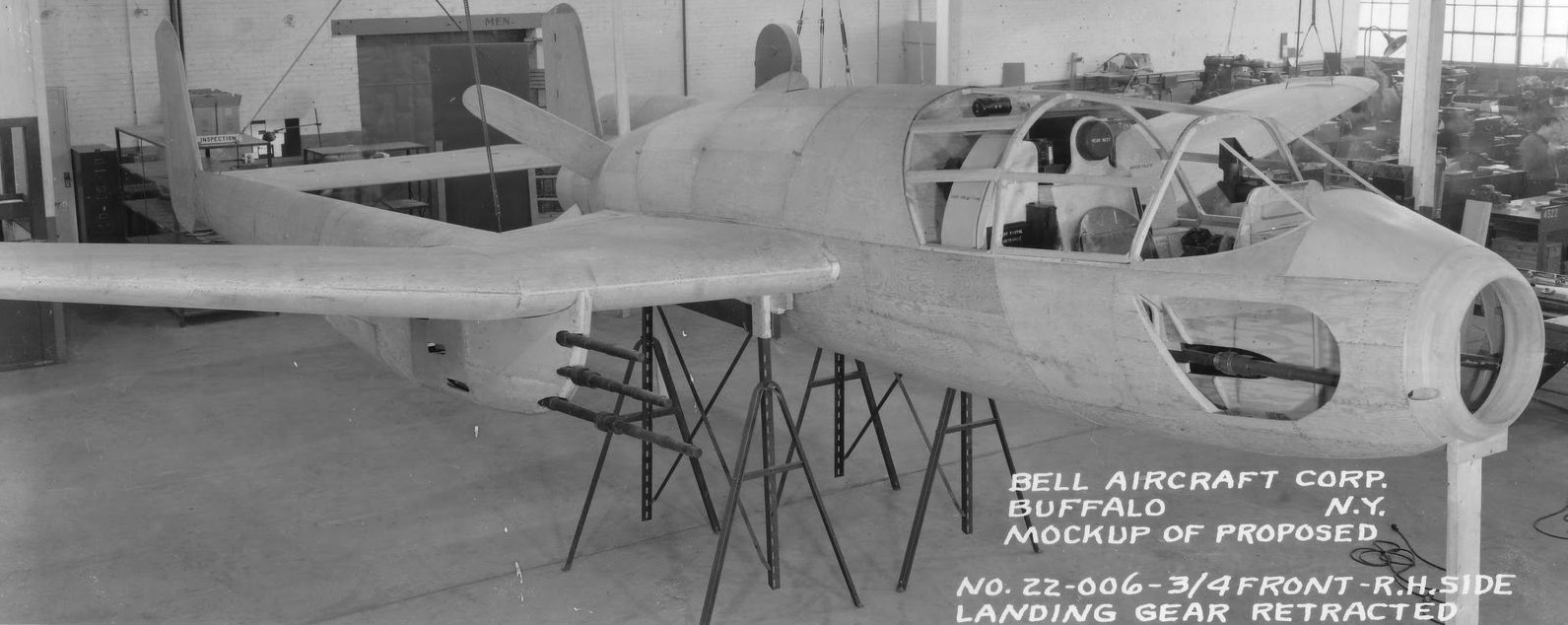
By the end of 1940, the Army purchasing commission had chosen six of the submissions for further development. Among them was the Bell Model 16. A single prototype was ordered under the designation XP-52. However this order was canceled on November 25, 1941, before anything could be built. It was replaced by an order for another Bell design, based on the XP-52 but equipped with a more-powerful Pratt & Whitney R-2800-52 air-cooled radial engine rated at 2000 hp and driving a pair of three-bladed contrarotating pusher propellers. This aircraft was assigned the designation XP-59 by the US Army. The XP-59 had more-or-less the same unorthodox configuration as that of the XP-52, complete with the unusual nose intake. Estimated maximum speed was 450 mph at 22,000 feet, and service ceiling was to have been 38,000 feet.
In the meantime, something happened in England which was to alter radically the fate of the XP-59. In April of 1941, Major-General H. H. Arnold paid a visit to Britain. While there, he was shown the top-secret Gloster E-28/39 jet-powered aircraft, powered by one of Wing Commander Frank Whittle's W2B centrifugal turbojets. Work on jet-powered aircraft was well-advanced in Britain, and similar projects were underway in both Germany and Italy. The USA was clearly behind other major aircraft manufacturing nations in this revolutionary new form of aircraft propulsion. General Arnold was so impressed by the potentiality of this new technology that he immediately asked if American engineers could be given the blueprints of the new jet engine so that they could manufacture it under license in the USA. Since the US government was being so generous with its Lend-Lease aid to Britain, the RAF readily agreed.
On September 4, 1941, at a meeting at Wright Field, General Arnold asked the General Electric Corporation of Schenectady, New York to act as the prime American contractor for license production of the British jet engine. General Electric was selected for this work because of the company's extensive experience with turbines for various industrial and aviation applications. Fifteen jet engines were ordered. This work was to be carried out under the utmost secrecy.
The very next day, Bell Aircraft of Buffalo, New York was approached and asked if it would build a fighter aircraft powered by the new General Electric jet engines. The choice of Bell as prime contractor for the manufacture of the first American jet fighter is sort of curious. Some have suggested that Bell was chosen because, of all the primary aircraft manufacturers in the USA, it had the least work to do in building aircraft vital for the war effort. Others have suggested that Bell was chosen because of its flair for imaginative design. Still others claim that Bell was chosen by General Arnold for this assignment primarily because of its proximity to the General Electric plant, a primary concern if strict secrecy was to be maintained. Perhaps all of these factors played a role.
Bell accepted the assignment, and agreed to build three aircraft. They accepted a deadline to complete the first prototype eight months after signing the contract on September 30, 1941. The serial numbers of the three prototypes were to be 42-108784/108786.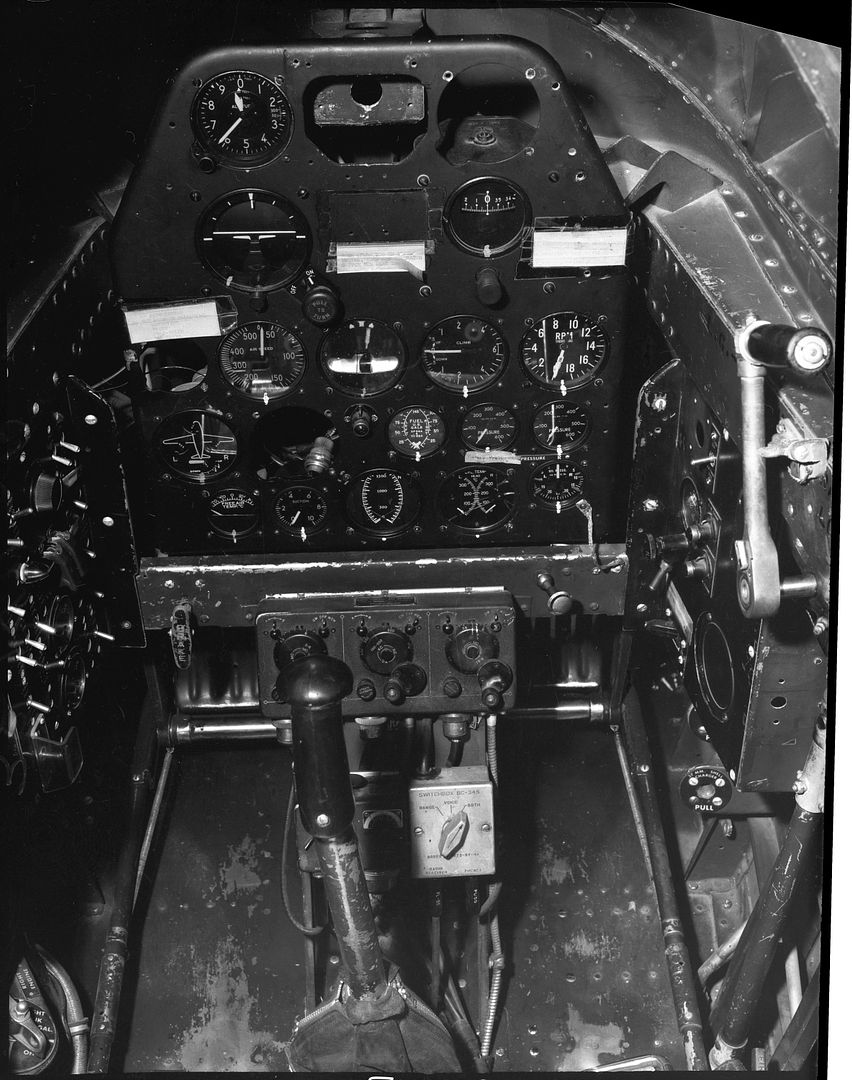
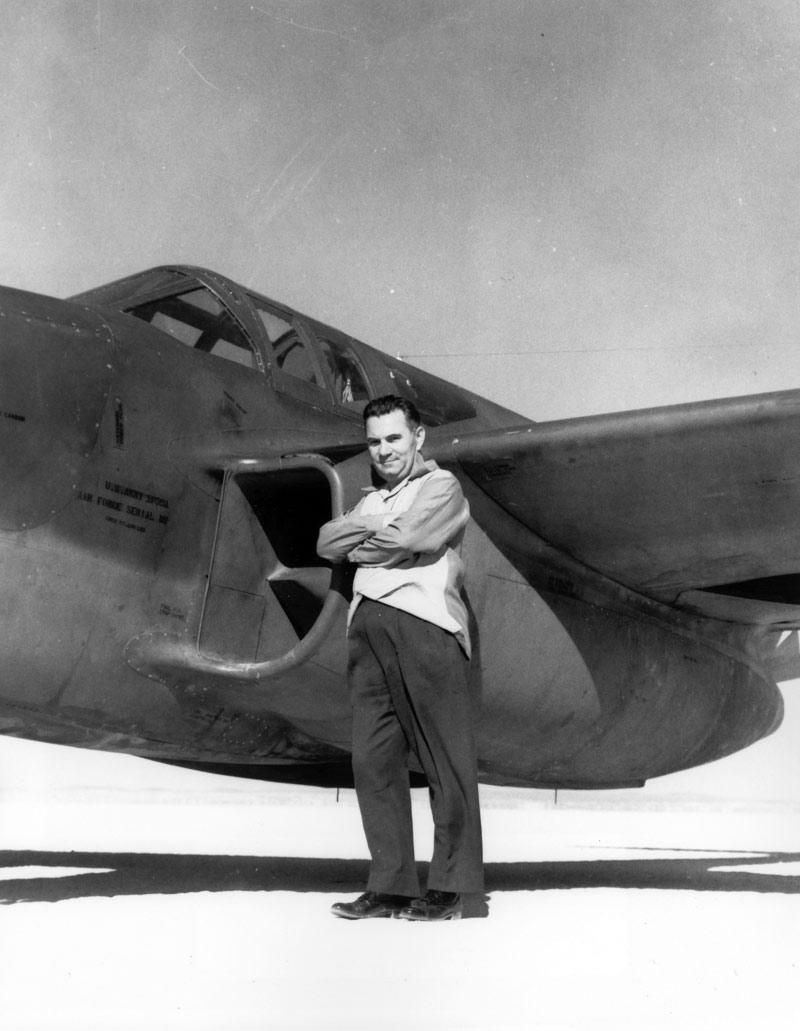
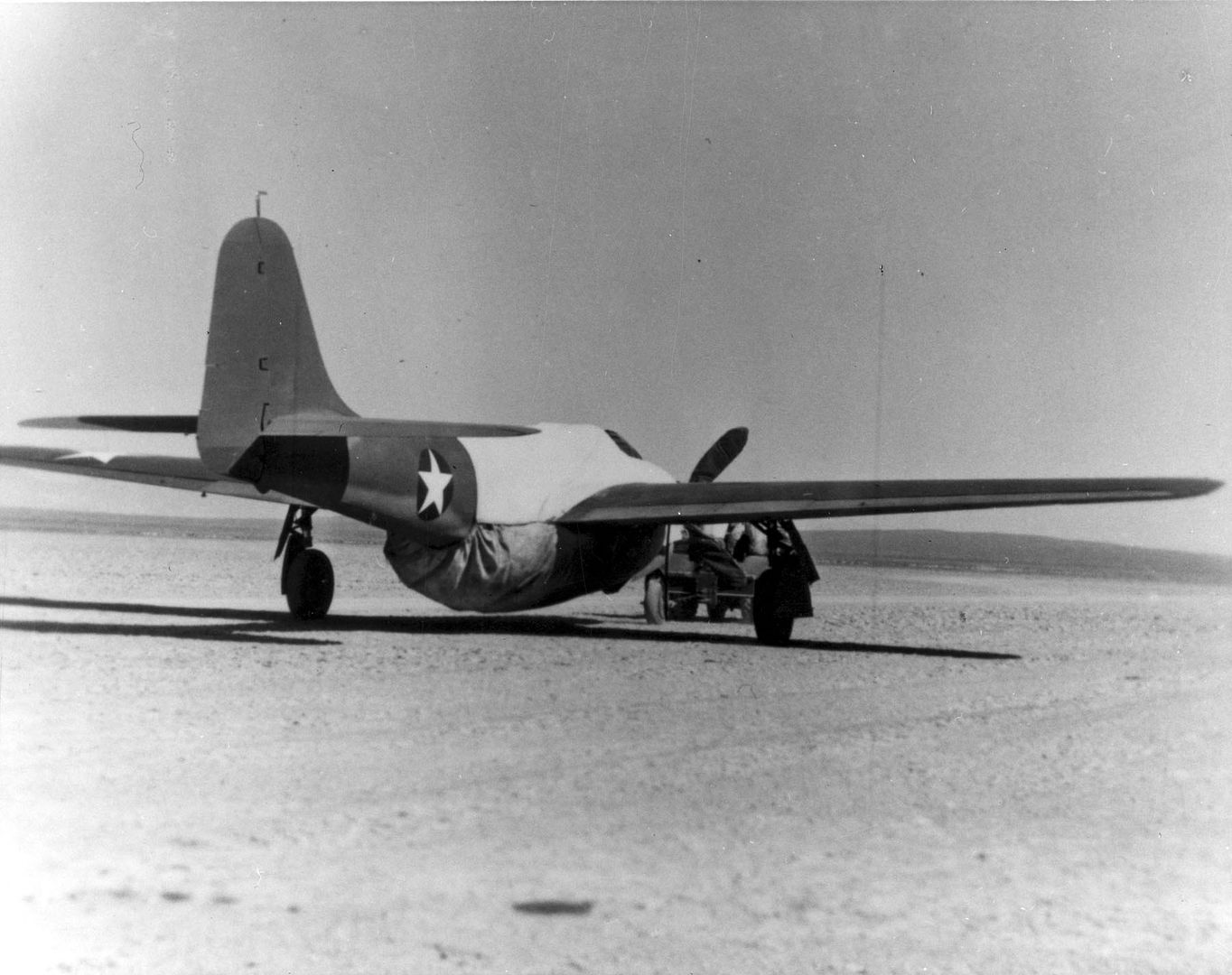
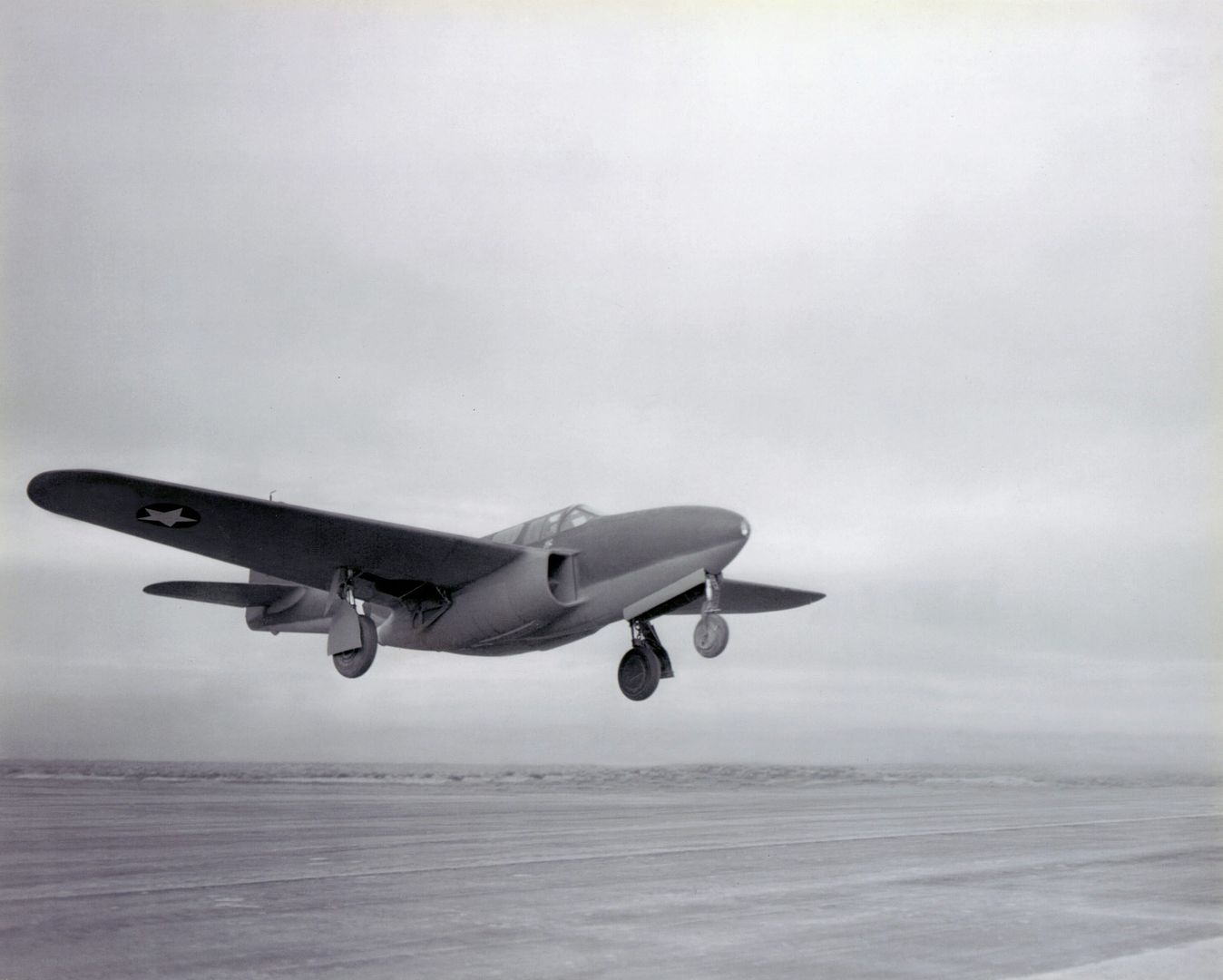
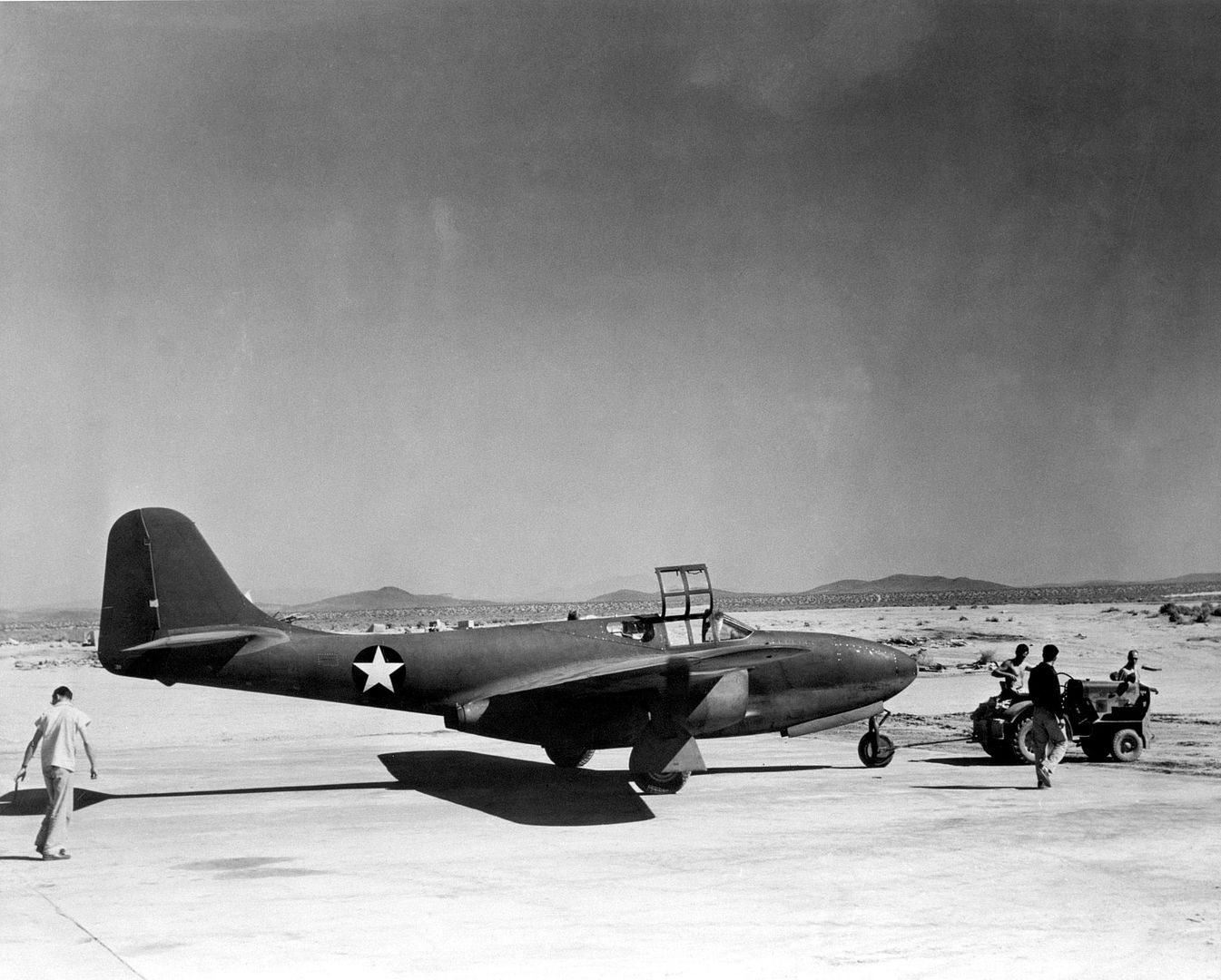
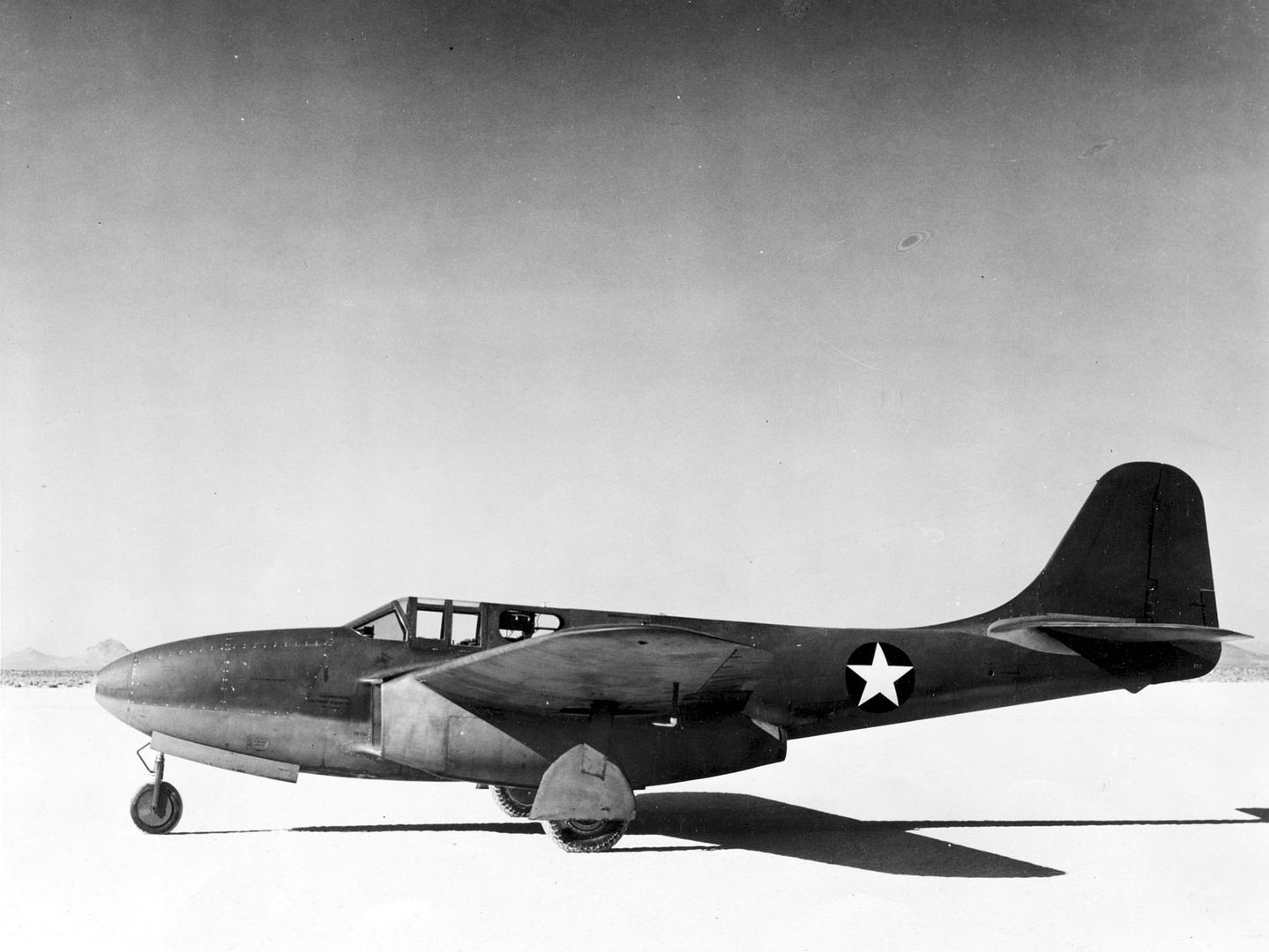
Below Jack Woolams standing established an unofficial U.S. altitude record when he climbed to 47600 feet in a prototype XP-59A Airacomet jet aircraft at Edwards AFB on December 15 1943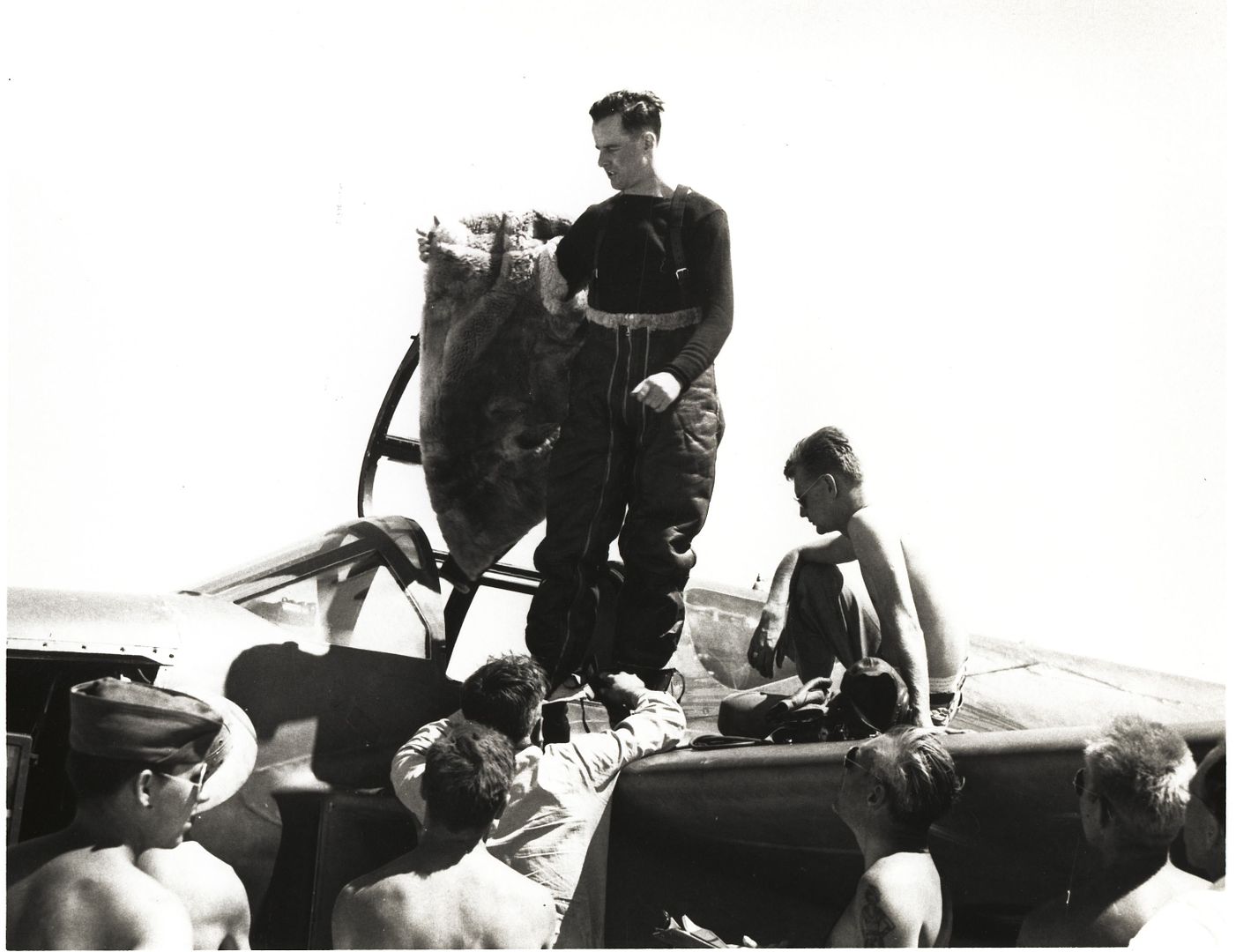
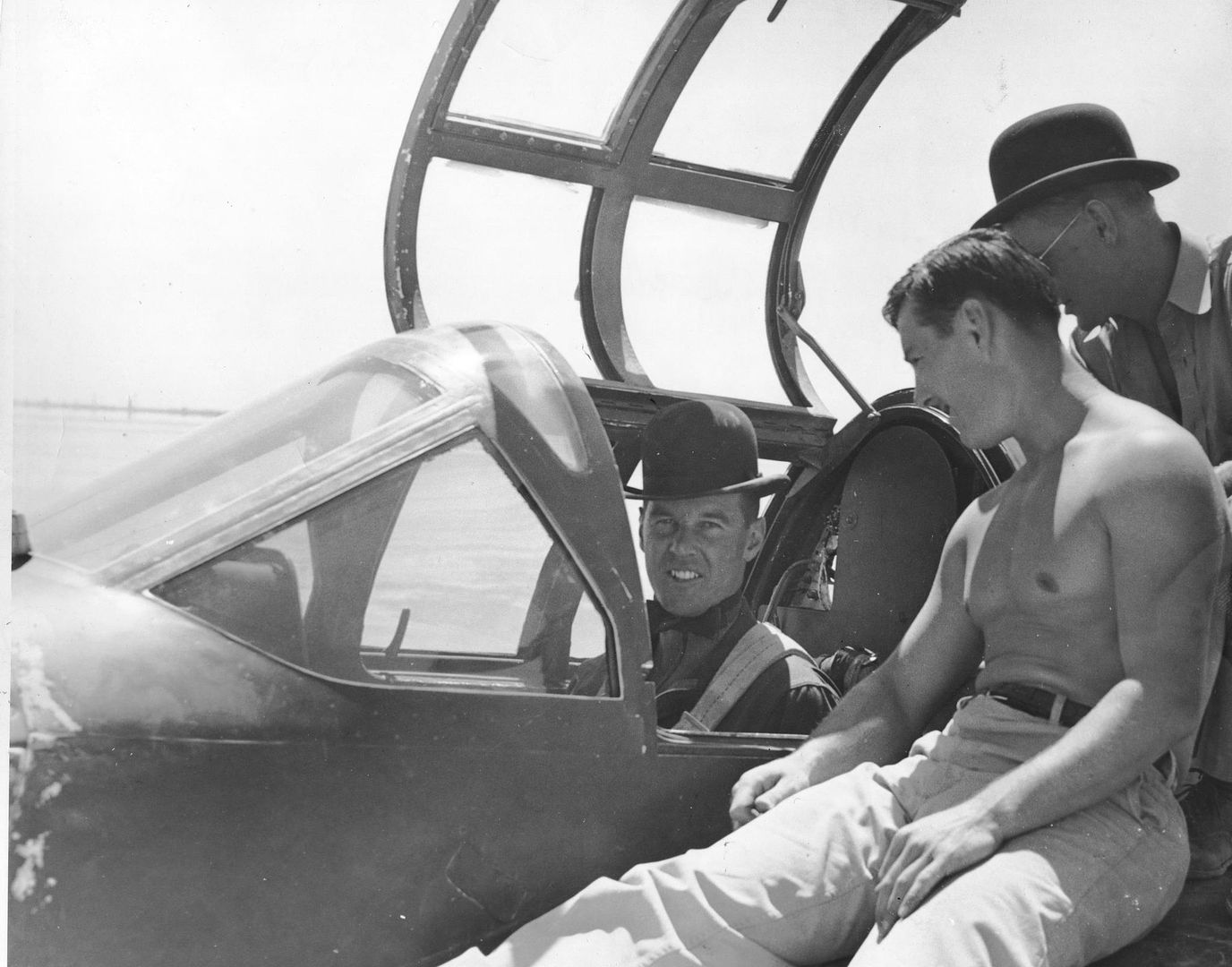
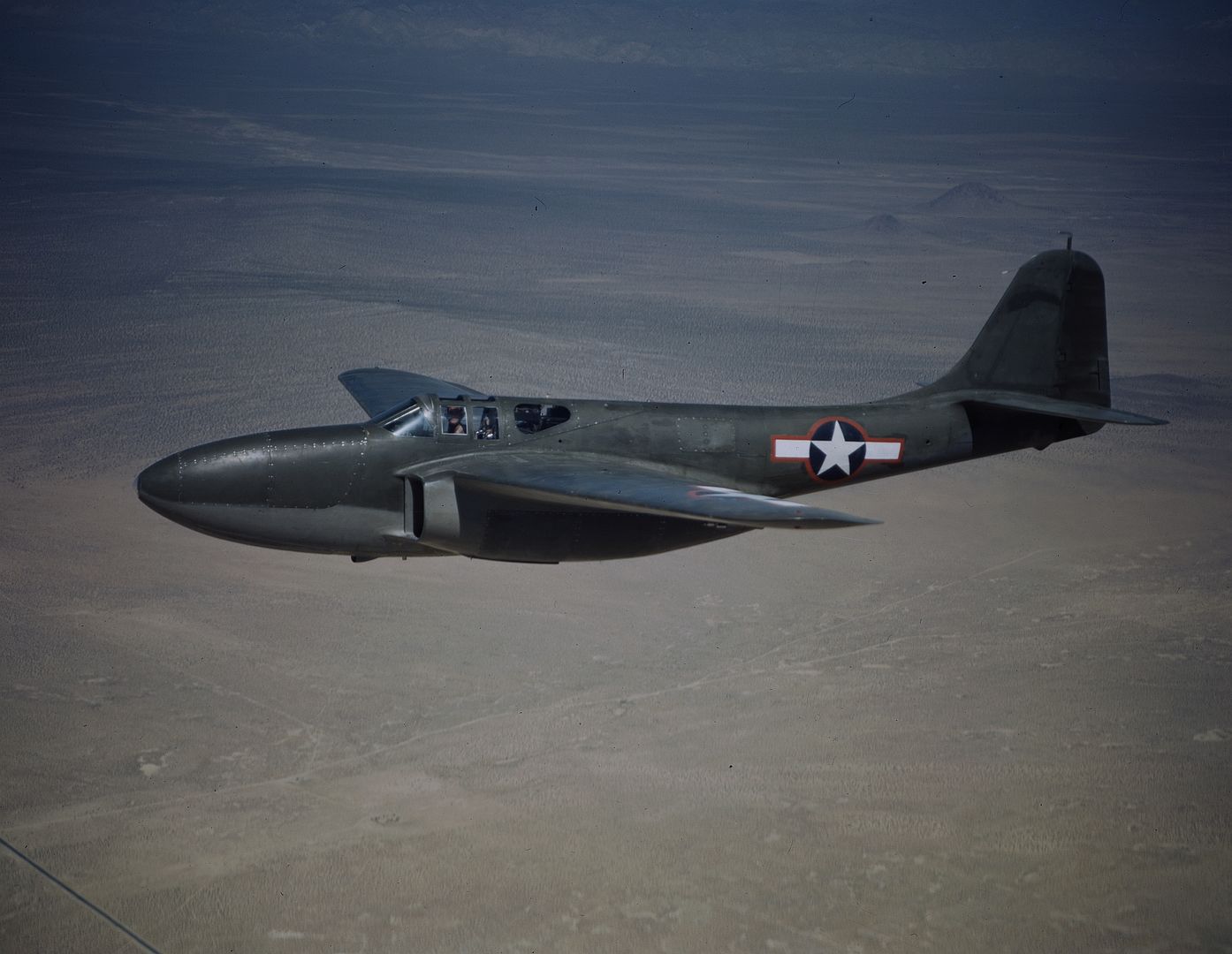
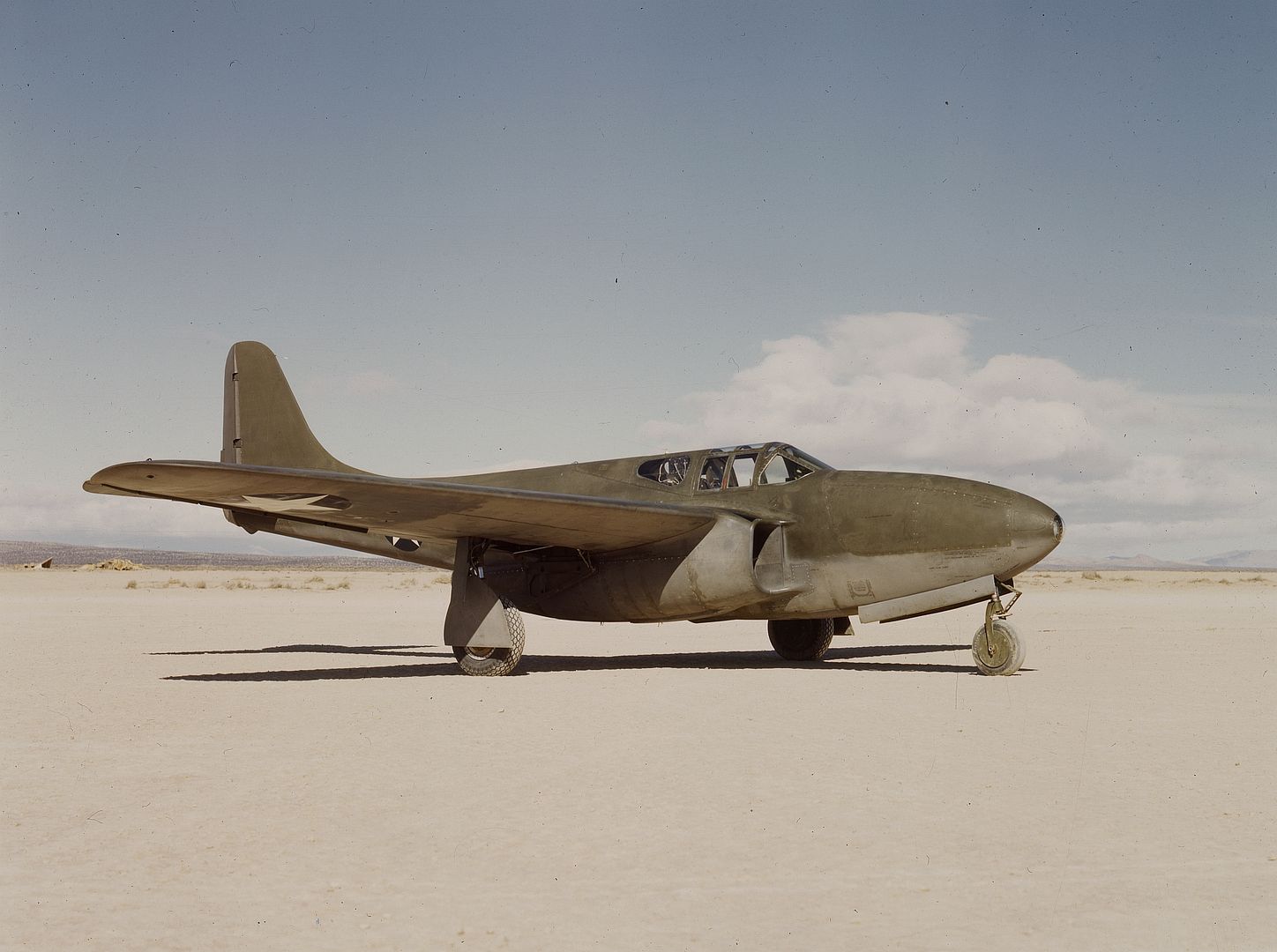
In order to provide for strict secrecy, some rather extreme measures were taken. In order to provide a cover, the Bell jet fighter project was assigned the designation XP-59A. This was done in the hope that even if Axis intelligence were to get wind of the XP-59A project, they would mistakenly think that it was just an adaptation of the totally-unrelated XP-59 piston-engined pusher fighter. At this time, Bell engineers were already hard at work on the XP-59 pusher, but work on this project was quietly abandoned in the next couple of months as work on the jet fighter got under way. The XP-59 project was officially cancelled on December 1, 1941.
The General Electric jet engine was assigned the cover designation I-A, in the hope that enemy intelligence might mistake it for a new turbosupercharger.
So the XP-59A and its jet engines were an early example of a "black" project. Many more such "black" projects were to follow in later years.
With the XP-59A project being given the highest priority, work proceeded very rapidly. Since the General Electric jet engines were being designed and built in parallel with the XP-59A, Bell engineers had little or no knowledge about performance data of the engines, so they adopted a fairly conservative design approach. Within two months after the initial order, Bell engineers had submitted a design for a fairly conventional aircraft, with a cantilever, laminar-flow, mid-mounted wing and a fully-retractable tricycle landing gear. The aircraft was fitted with two 1400 lb. st. General Electric I-A jet engines, one mounted on either side of the fuselage under the wing roots. The aircraft had a high tailplane, well out of the way of the turbojet exhausts. It was fitted with a pressurized cockpit, still a rather unusual feature for the time. Access to the cockpit was through a side-hinged canopy. The fuselage was to be built in two sections, the forward section comprising armament bay and cabin, and the rear section being of stressed-skin semi-monocoque construction. All control surfaces were fabric covered and manually-operated, the ailerons being of the pressure-balance type with pressure seals. The aircraft was fitted with aerodynamically-balanced, fabric-covered flaps located inboard of the ailerons. Although the XP-59A was primarily viewed as a test-bed for jet engines, the USAAF also viewed it as a potential combat aircraft, and it was to carry a nose-mounted armament of two 37-mm cannon with 44 rpg.
The USAAF approved the initial design, and construction of the three prototypes got underway on January 9, 1942.
Without even waiting for the flight of the first XP-59A prototype, the USAAF ordered thirteen service test YP-59As in March of 1942. Serial numbers of the YP-59As were 42-108771/108783. These were to be powered by improved versions of the General Electric engine, the I-16 (later designated J-31) rated at 1650 lb. st. each. They were to have rearward-sliding cockpit canopies in place of the hinged canopies of the prototypes.
The first XP-59A prototype was ready by the late summer of 1942, and was ferried by rail out to Muroc Dry Lake, California (now Edwards AFB) on September 12, 1942. Once it arrived in California, it was fitted with a dummy propeller attached to its nose, just in case the curious might see it and start asking why this aircraft didn't have a propeller. On October 1, 1942, Bell's test pilot Robert Stanley was undergoing some high-speed taxiing trials with the XP-59A when the aircraft "inadvertently" became airborne for a short time. It made its first official flight the next day, with a USAAF pilot at the controls. This was remarkably rapid progress, the first flight of the prototype taking place only 13 months after the contract had first been awarded. The XP-59A weighted 7320 pounds empty and 12,562 pounds maximum loaded. Wingspan was 45 feet 6 inches, length was 28 feet 2 inches, height was 12 feet 4 inches, and wing area was 386 square feet.
As might be expected for such a revolutionary system of aircraft propulsion, there were serious problems right from the start. The jet engines were too heavy in relation to the amount of power they could develop, and their exhaust was so hot that the turbine blades regularly overheated and often broke off with catastrophic results. The maximum speed was 404 mph at 25,000 feet, somewhat below expectations. The engine installation was found to result in an inordinate amount of aerodynamic interference, and the aircraft was subject to severe directional snaking, making it a poor gun platform. Nevertheless, work on the P-59 continued unabated, and remedies were eventually found for its long list of faults.
The second XP-59A flew on February 15, 1943 and the third late in April.
The first YP-59A reached Muroc in June of 1943, and the USAAF gave the aircraft the name *Airacomet*. The first YP-59A flew in August of 1943. The YP-59A had more powerful 1650 lb. st. General Electric I-16 (J31) turbojets. However, the YP-59A showed little improvement in performance over the XP-59A. Empty weight increased to 7626 pounds, and maximum speed was a disappointing 409 mph at 35,000 feet. Service ceiling was 43,200 feet. The last four YP-59As had a heavier armament--three 0.50-inch machine guns and a single 37-mm cannon, which had been standardized for the production P-59A.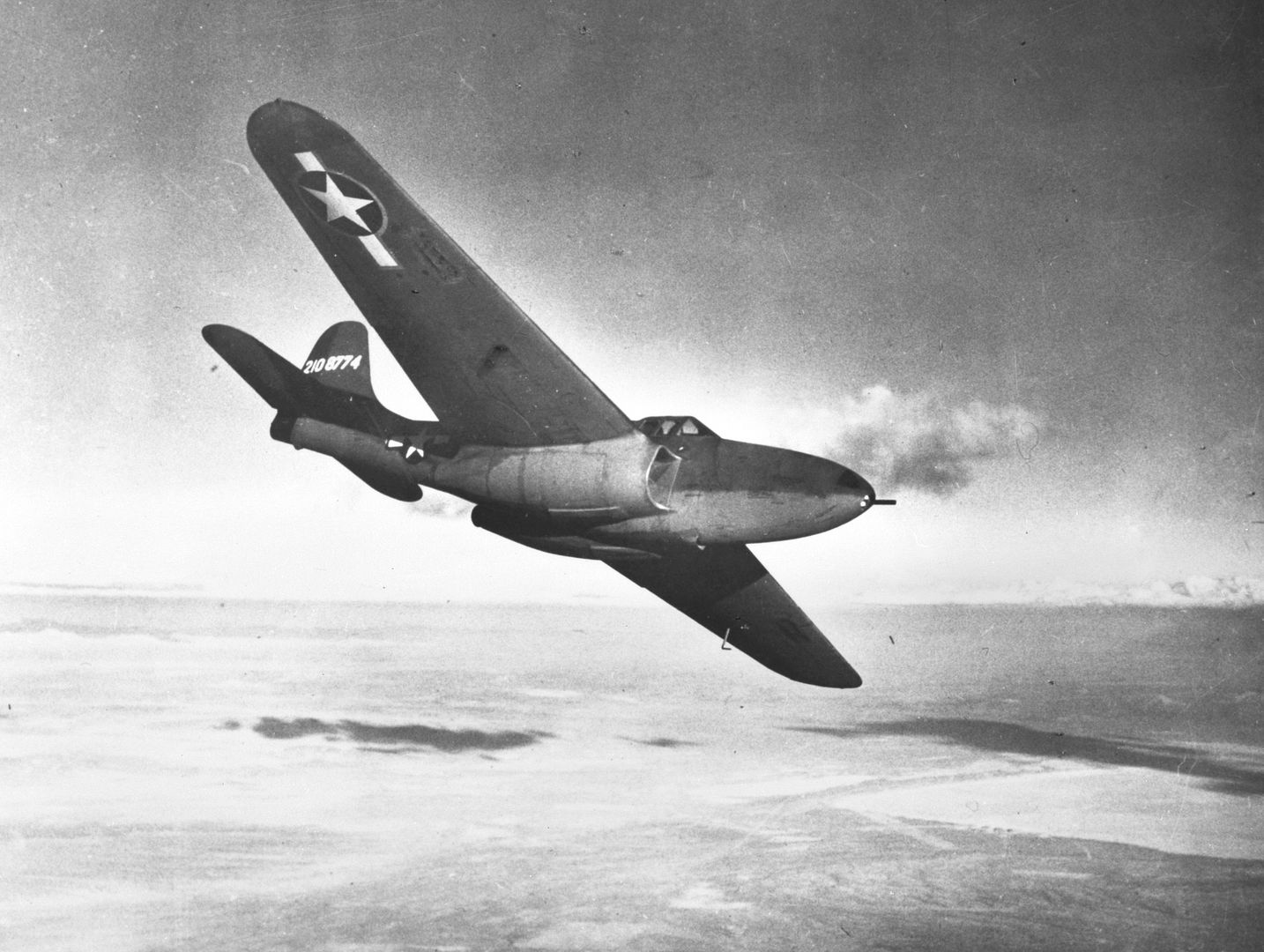
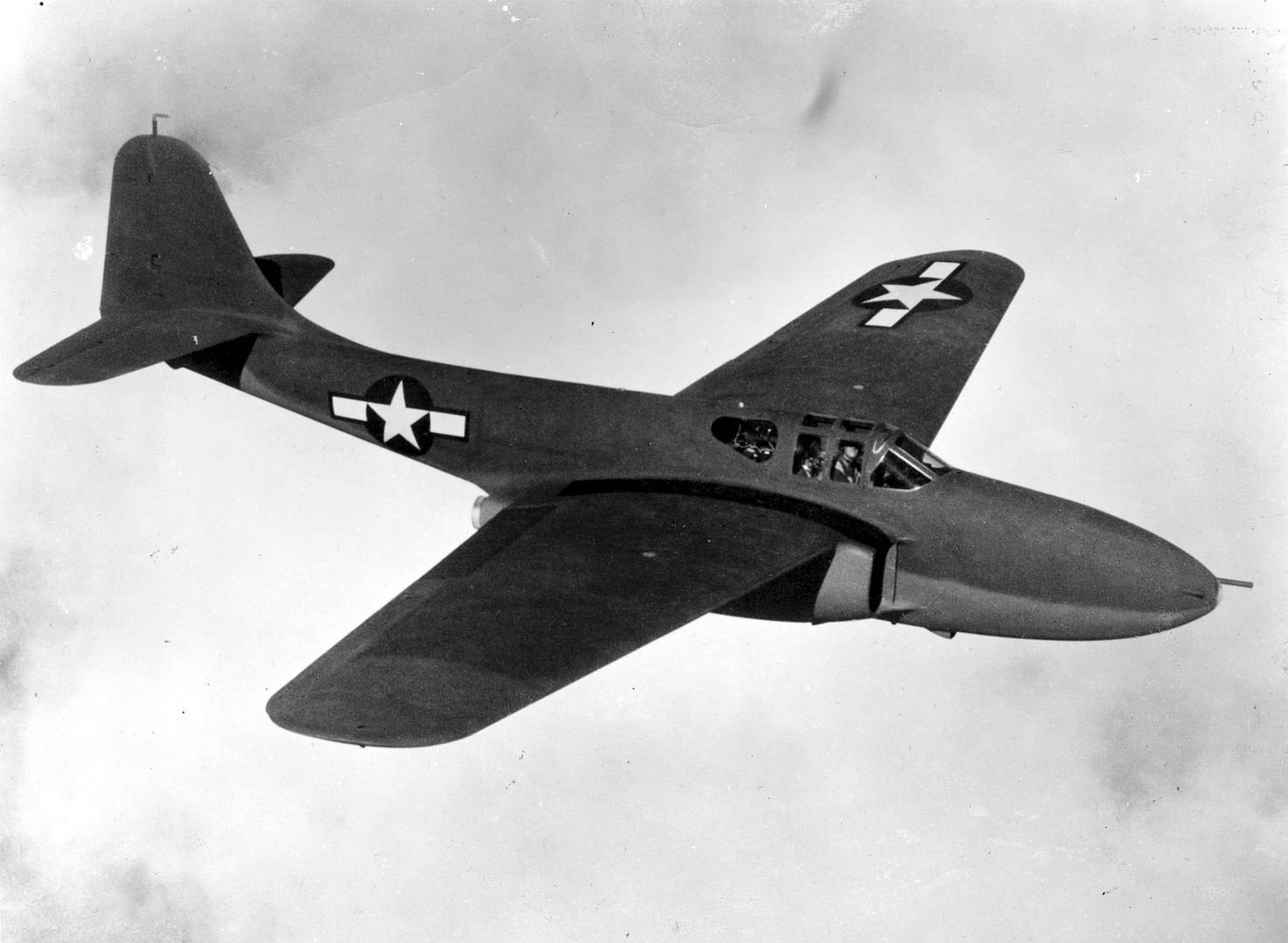
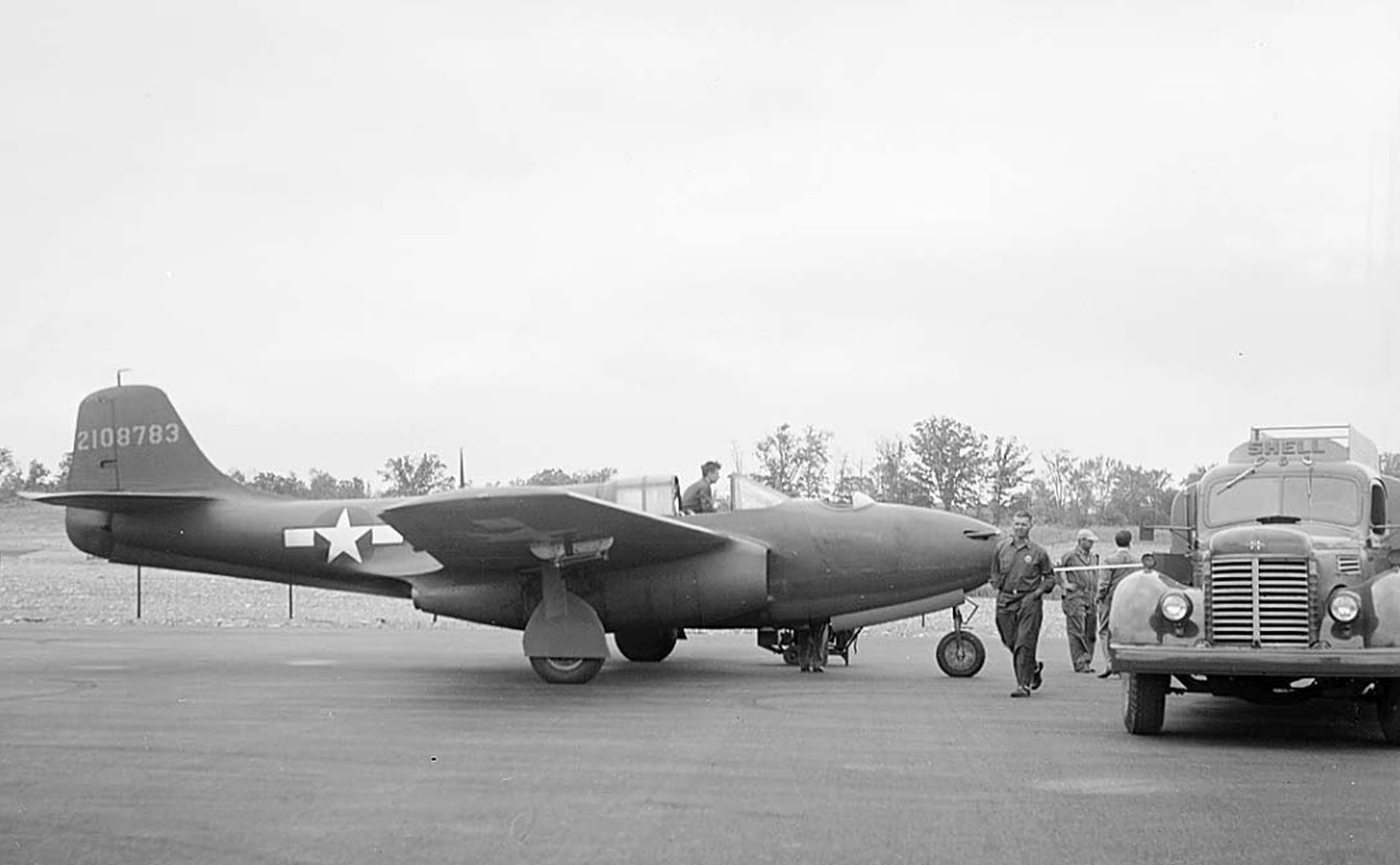
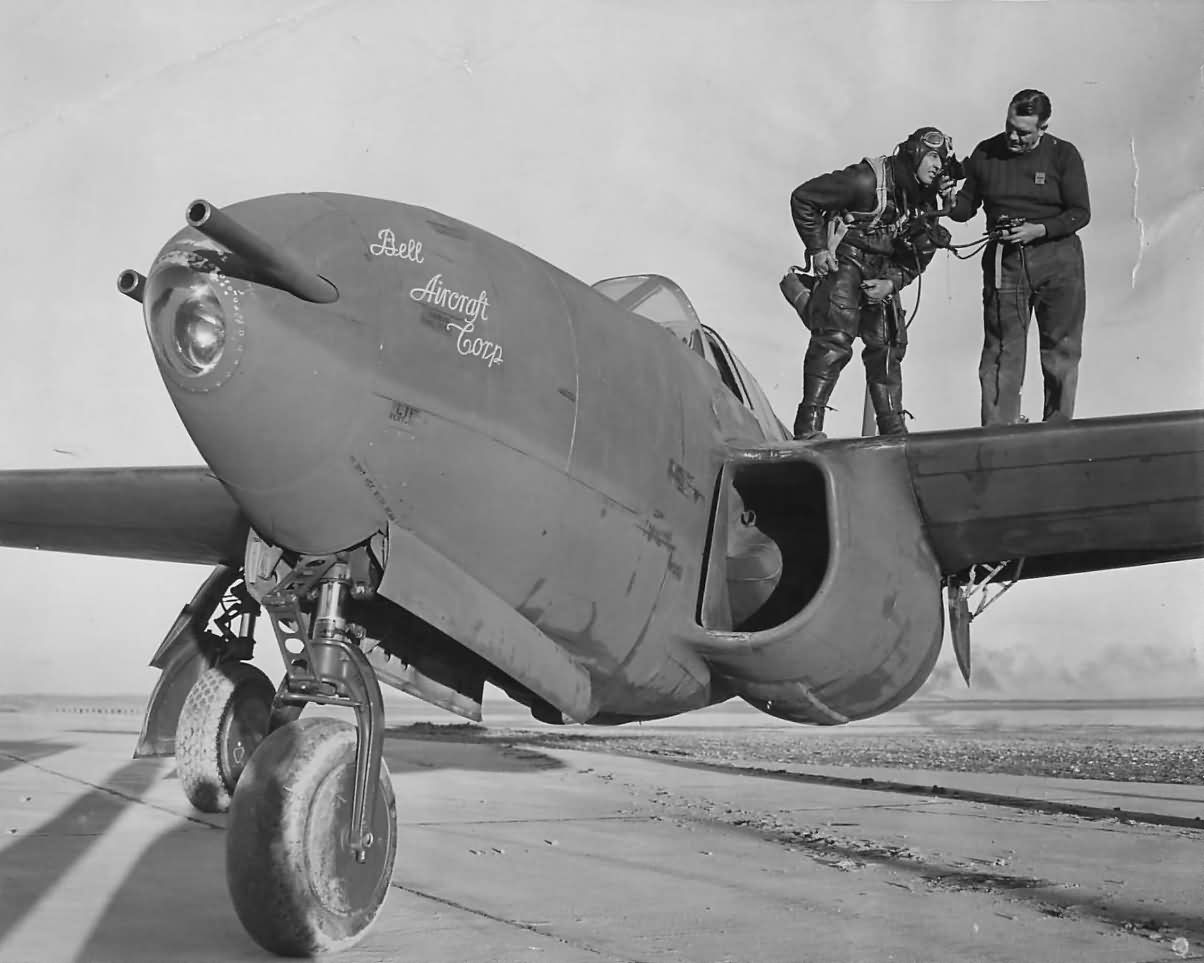
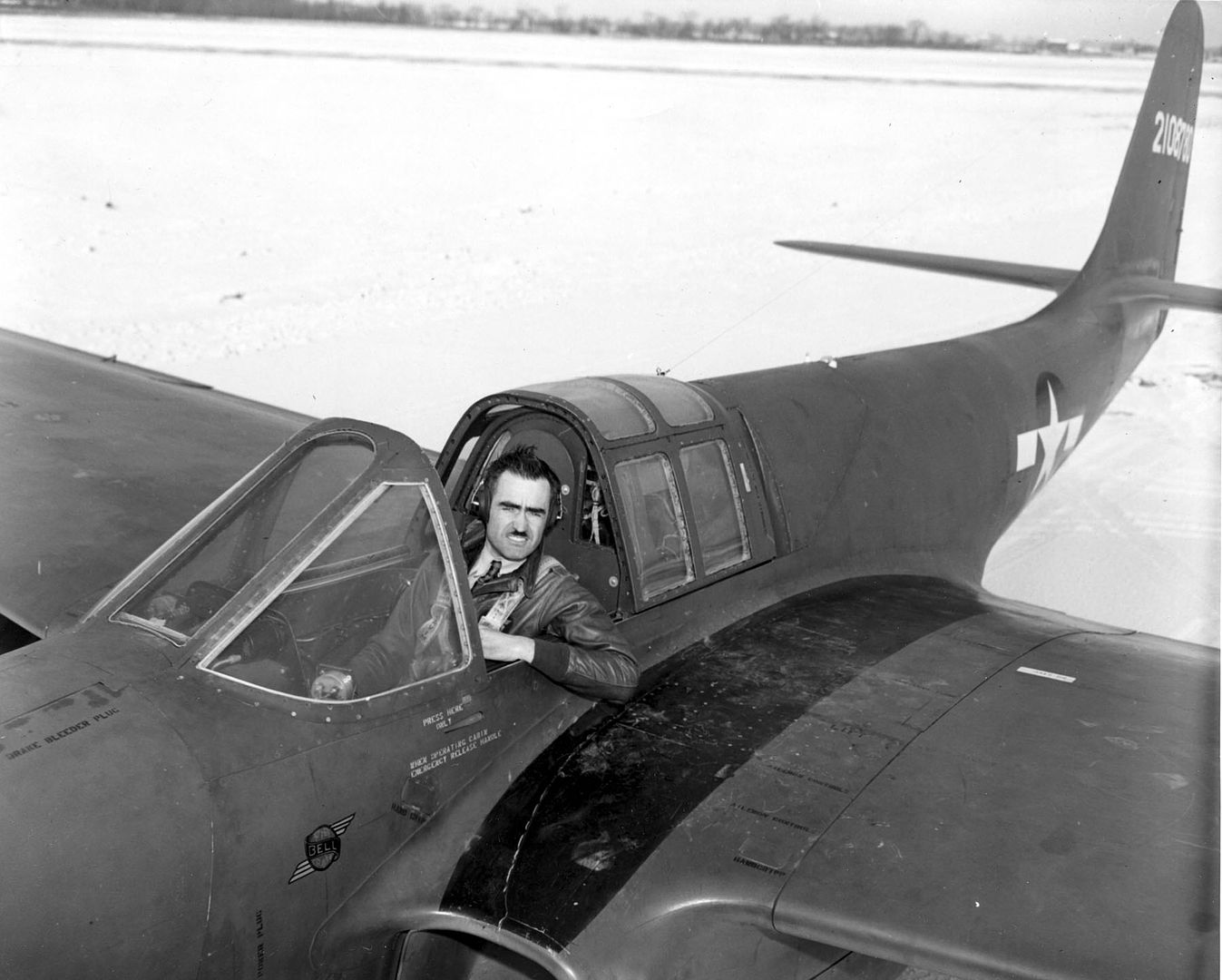
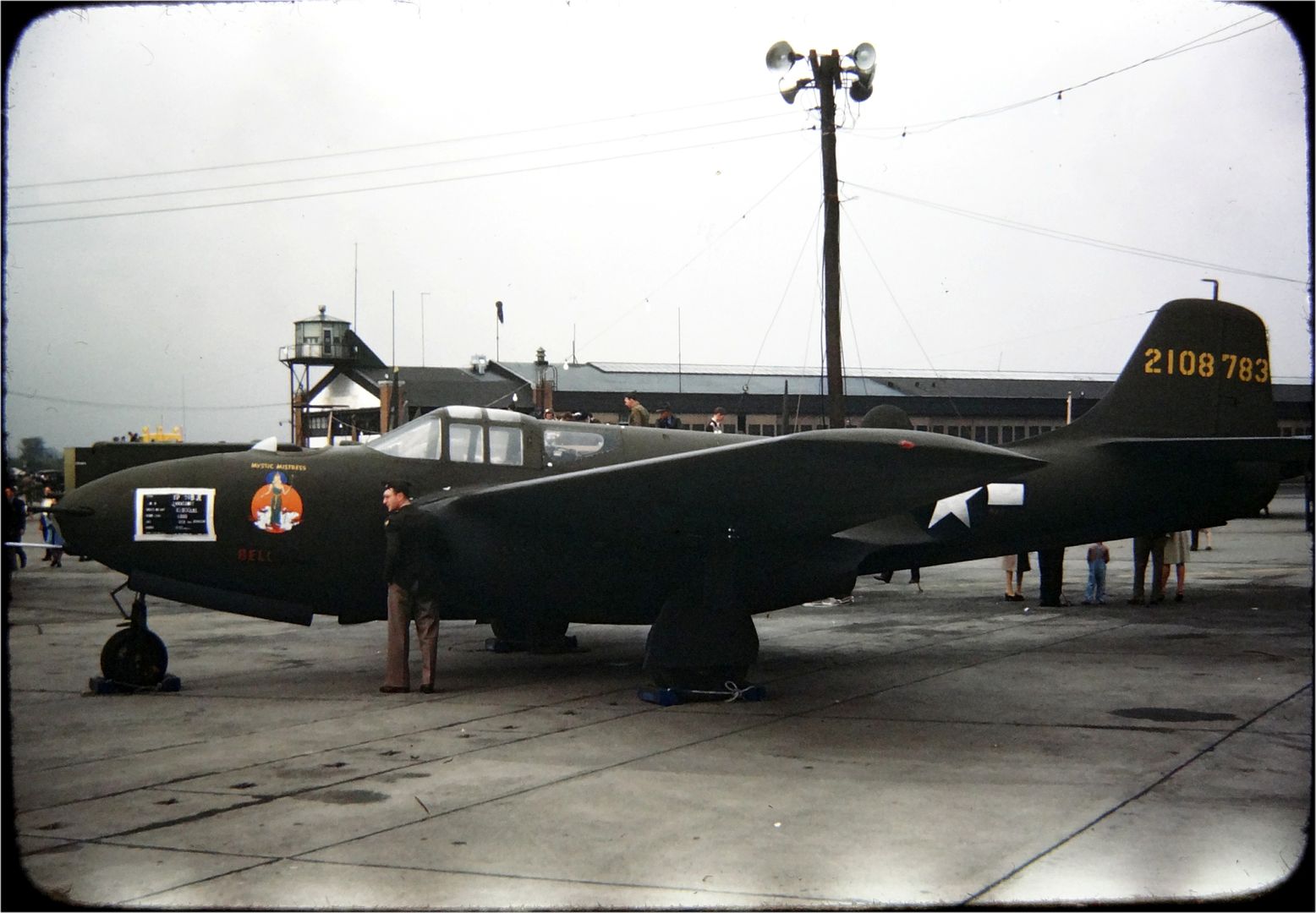
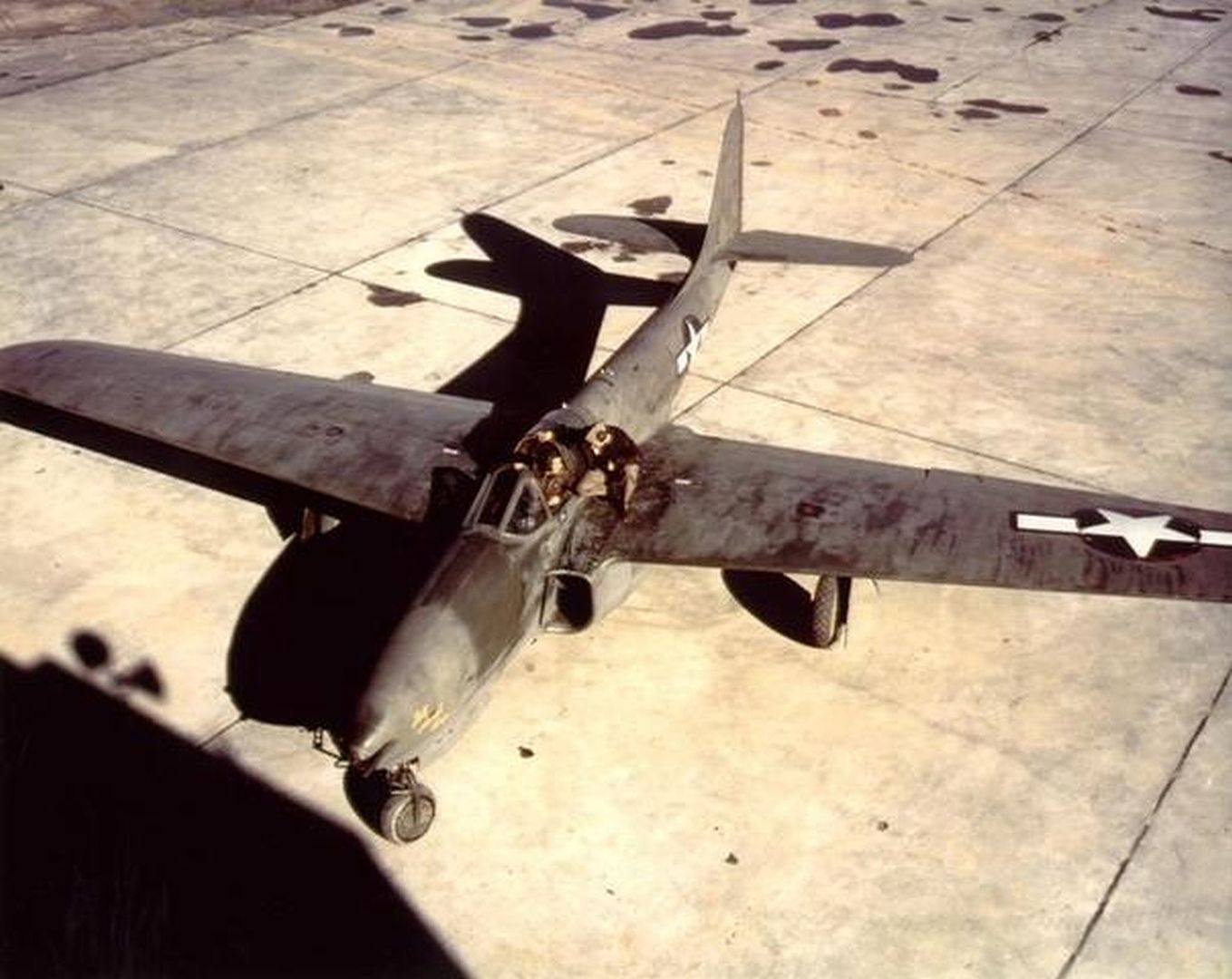
The third YP-59A (Ser No 42-22611) was shipped to Britain in exchange for the first production Gloster Meteor I. Upon arrival in England, it was assembled by Gloster at Moreton Vallance, where it was flown for the first time by a Bell test pilot on September 28, 1943. It was assigned the RAF serial number of RJ362/G. It was transferred to the Royal Aircraft Establishment at Farnborough on November 5, 1943. It was on the top-secret Jet Flight list (along with the Gloster E.28/39, the De Havilland Vampire, and the Gloster Meteor), but the Airacomet was flown very little because of unserviceability and the lack of spares. The RAF test pilots found the aircraft to be badly underpowered, with an unacceptably-long takeoff run. Like all other early jet-powered fighters, the Airacomet suffered from very poor engine acceleration.
In December of 1943, the US Navy got the eighth and ninth YP-59As (42-108778 and 42-100779) for use in tests. Some sources list their naval designation as being YF2L-1, which is sort of curious since the F2L designation was also used by a couple of Bell P-39Q Airacobras employed by the Navy as target aircraft. Perhaps this inconsistency was simply a part of the overall program of official deception, in the hope that enemy intelligence would mistakenly think that the jets were simply more naval Airacobras. In any case, the Airacomet was totally unsuited for carrier operations because of the poor view from its cockpit and the poor acceleration of its engines. In addition, the Airacomet suffered from a lack of adequate drag during landing approaches, so that there was a lot of "float" before touchdown when the power was cut. The lack of drag was primarily caused by the absence of dive brakes, which had been deliberately omitted because of the Airacomet's anticipated mediocre performance.

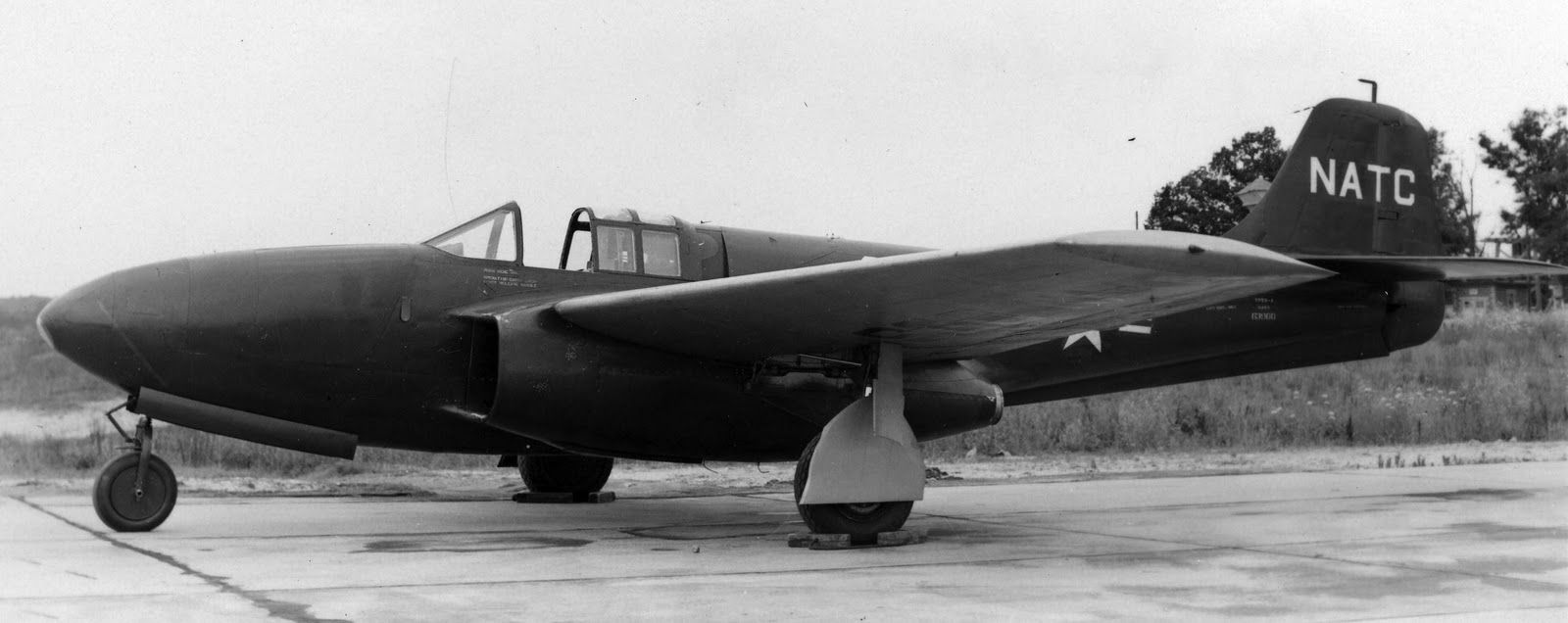
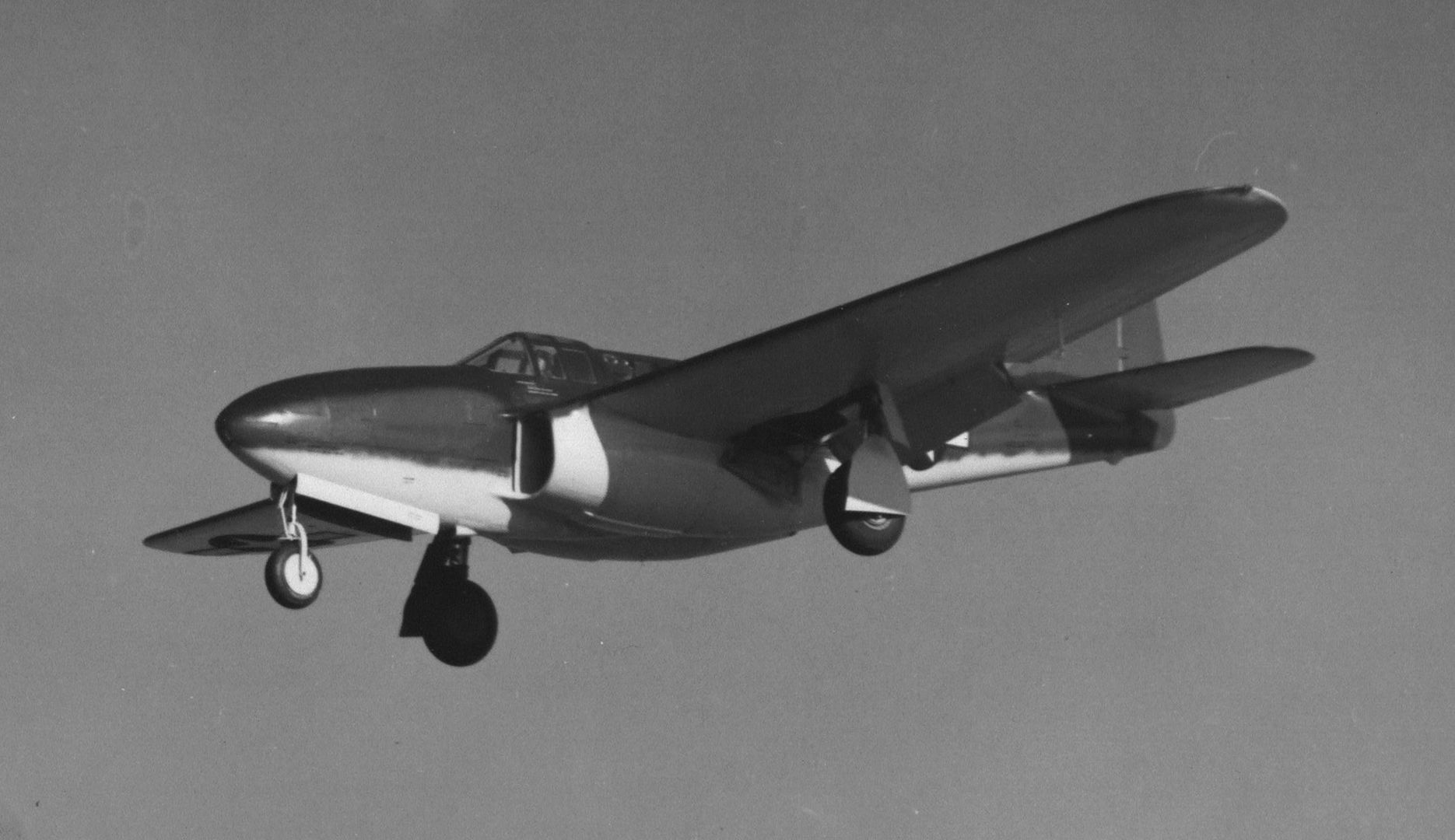
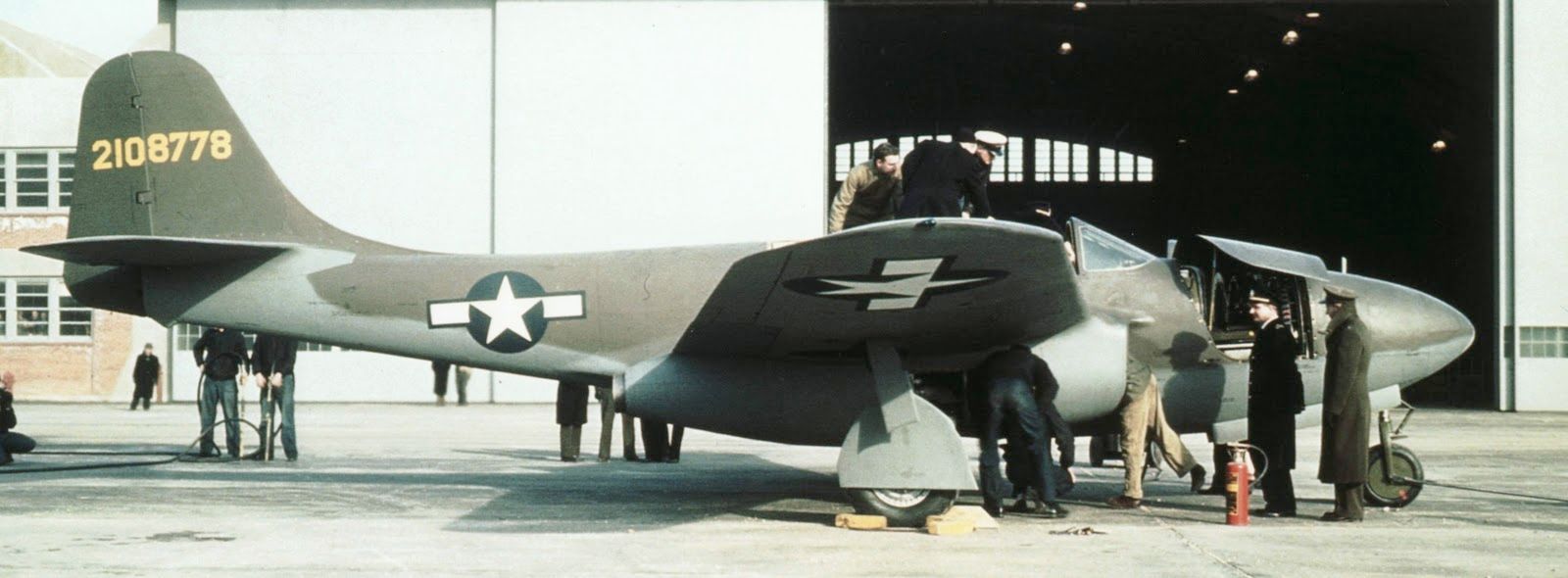
The last YP-59A had been delivered by the end of June 1944.
Shortly before the first flight of the XP-59A, the USAAF had placed an order for one hundred P-59A Airacomets. However, the performance of the YP-59A service test aircraft had proved to be rather disappointing, not even up to the standards of conventional piston-engined fighter aircraft already in service with the USAAF. It was considered rather unlikely that any appreciable improvements in the performance of the P-59 would be soon be forthcoming, and by the early fall of 1943 the Airacomet was no longer considered by the USAAF as being worthy of consideration as an operational combat type. The Airacomet was therefore relegated to the operational training role, and the P-59A order was halved on October 30, 1943.
The production P-59A differed very little from the YP-59A. Only the first twenty of the P-59A order were actually completed as P-59As. Serials were 44-22609/22628. Most of these P-59As were powered by a pair of 1650 lb. s.t. General Electric J31-GE-3 turbojets, although the last few were powered by uprated 2000 lb. st. J31-GE-5 turbojets. The J31-GE-5-powered P-59A had a maximum speed of 413 mph at 30,000 feet and 380 mph at 5000 feet. Range on internal fuel was 240 miles, and range with two 125-Imp. gall. drop tanks was 520 miles. An altitude of 10,000 feet could be reached in 3.2 minutes, and 20,000 feet in 7.4 minutes. Weights were 7950 pounds empty, 10,822 pounds loaded, 12,700 pounds maximum. Dimensions were wingspan 45 feet 6 inches, length 38 feet 10 inches, height 12 feet 4 inches, and wing area 385.8 square feet. Armament consisted of one 37-mm cannon and three 0.50-inch machine guns, all mounted in the nose. In addition, two 1000-pound bombs or eight 60-pound rockets could be carried on underwing racks.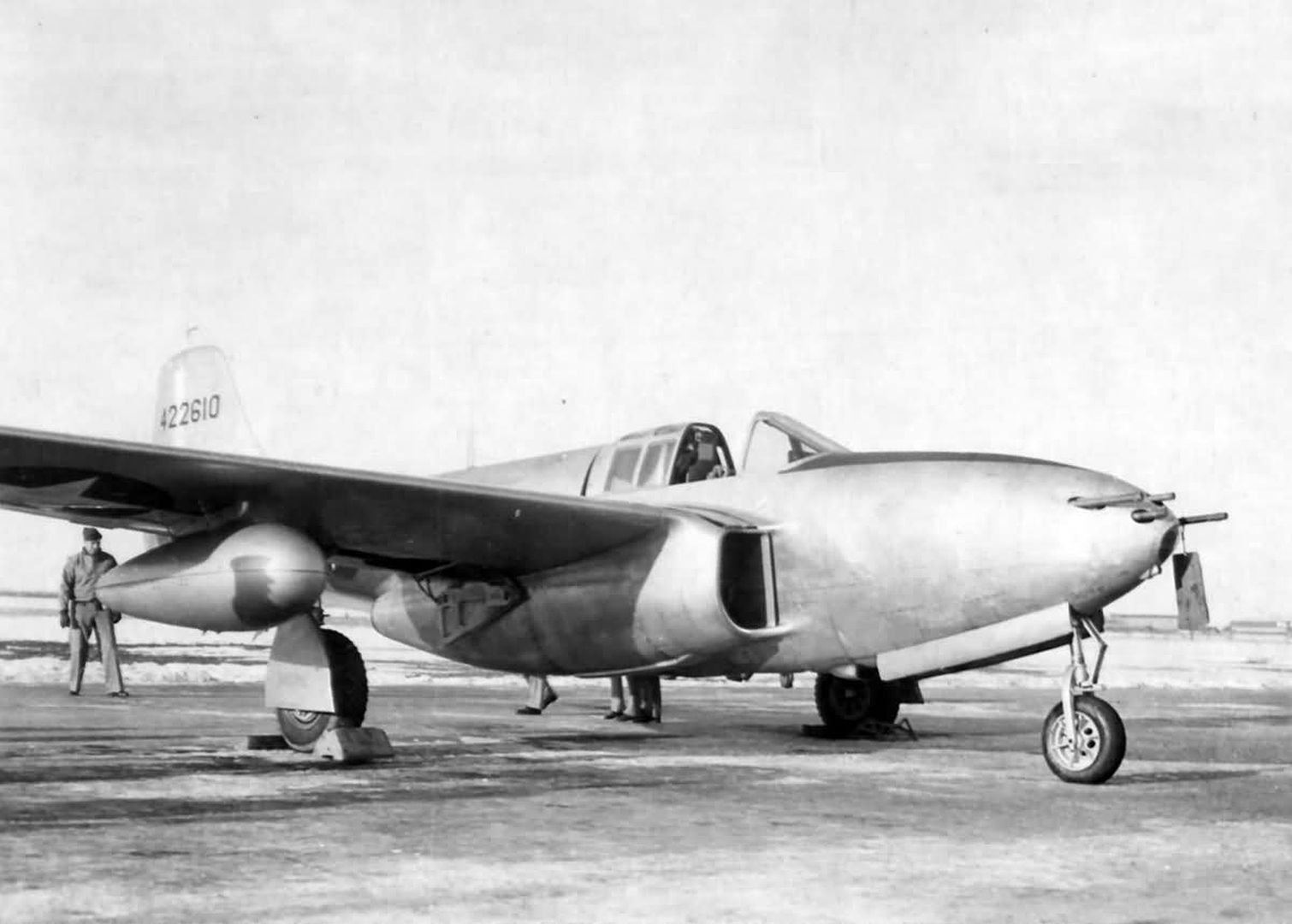
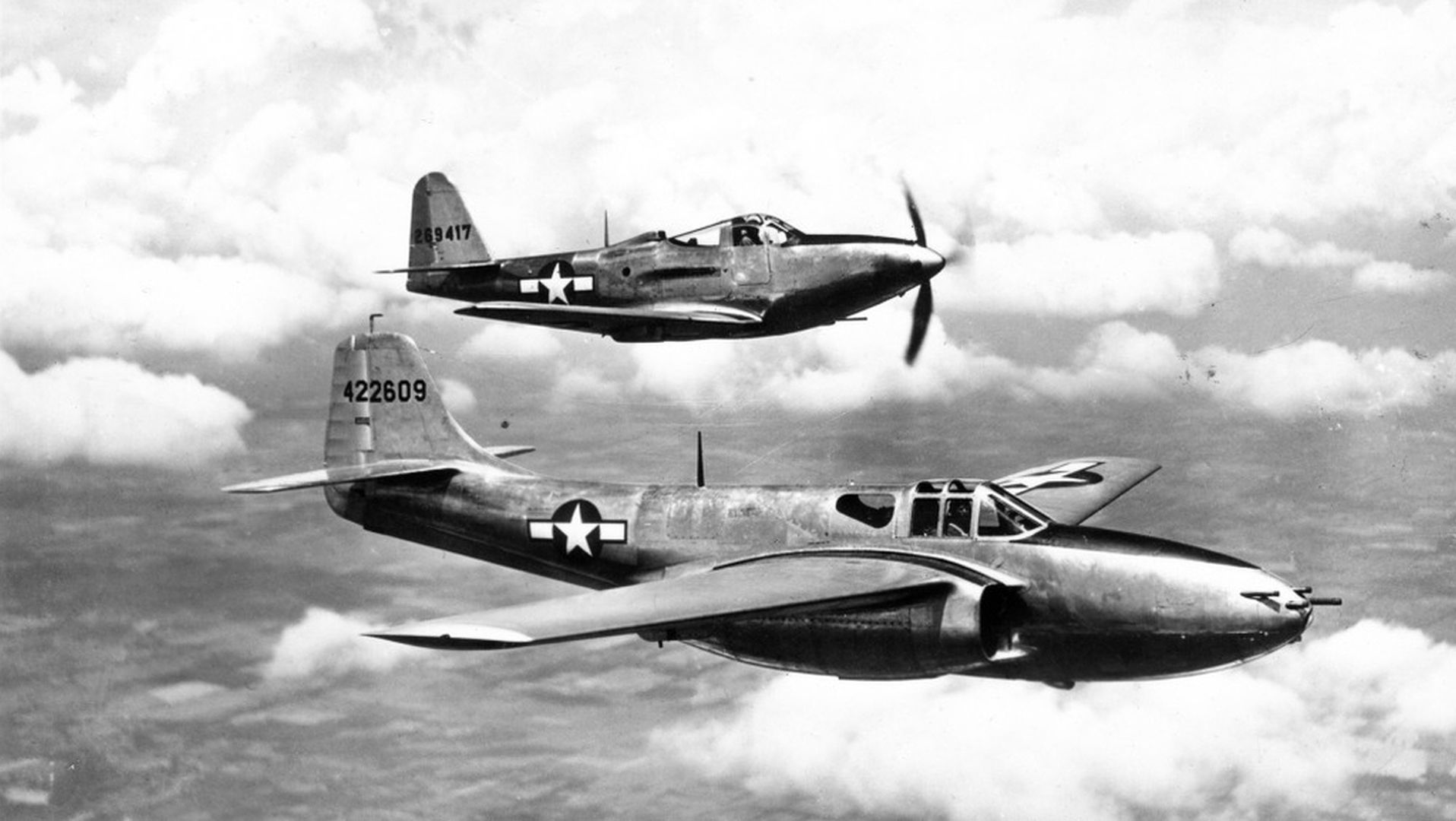
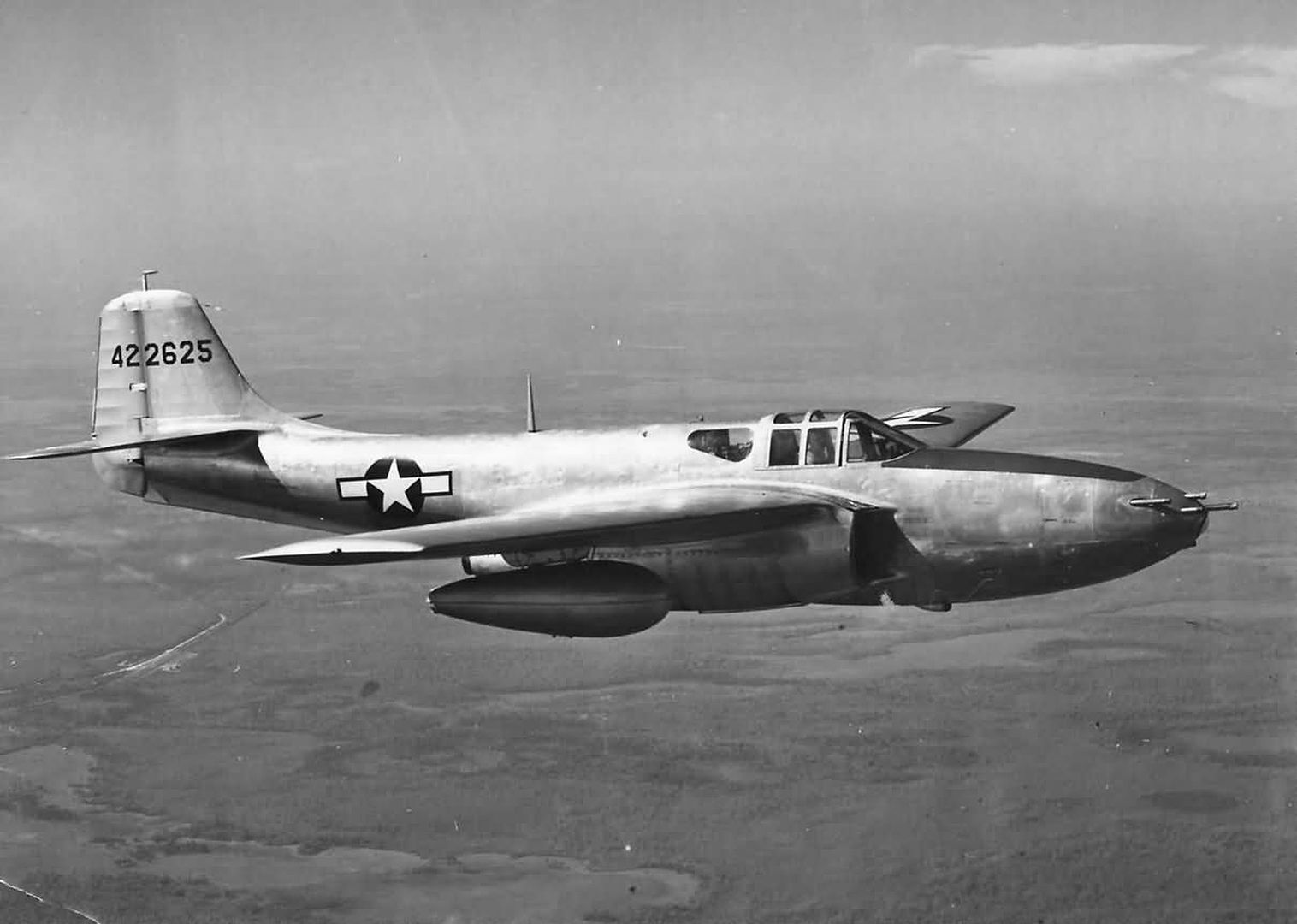
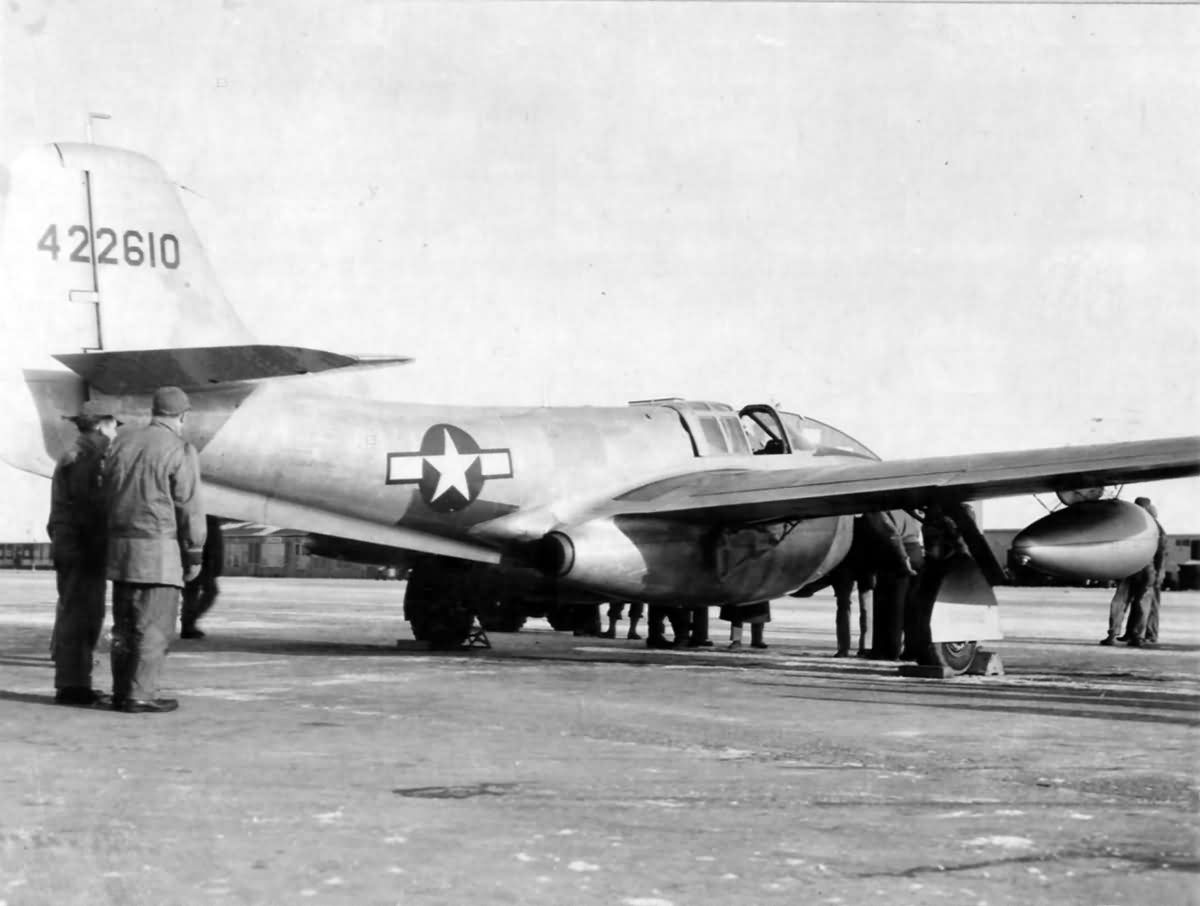

The twenty-first and remaining twenty-nine Airacomets of the P-59A order were completed as P-59Bs. Serials were 44-22629/22658. They had the uprated J31-GE-5 jets of the later P-59As, but had internal fuel capacity increased by 55 Imp gall. Maximum range was increased to 950 miles. Empty weight of the P-59B was increased to 8165 pounds and normal and maximum loaded weights were 11,049 pounds and 13,700 pounds respectively. The last P-59B was delivered in May of 1945.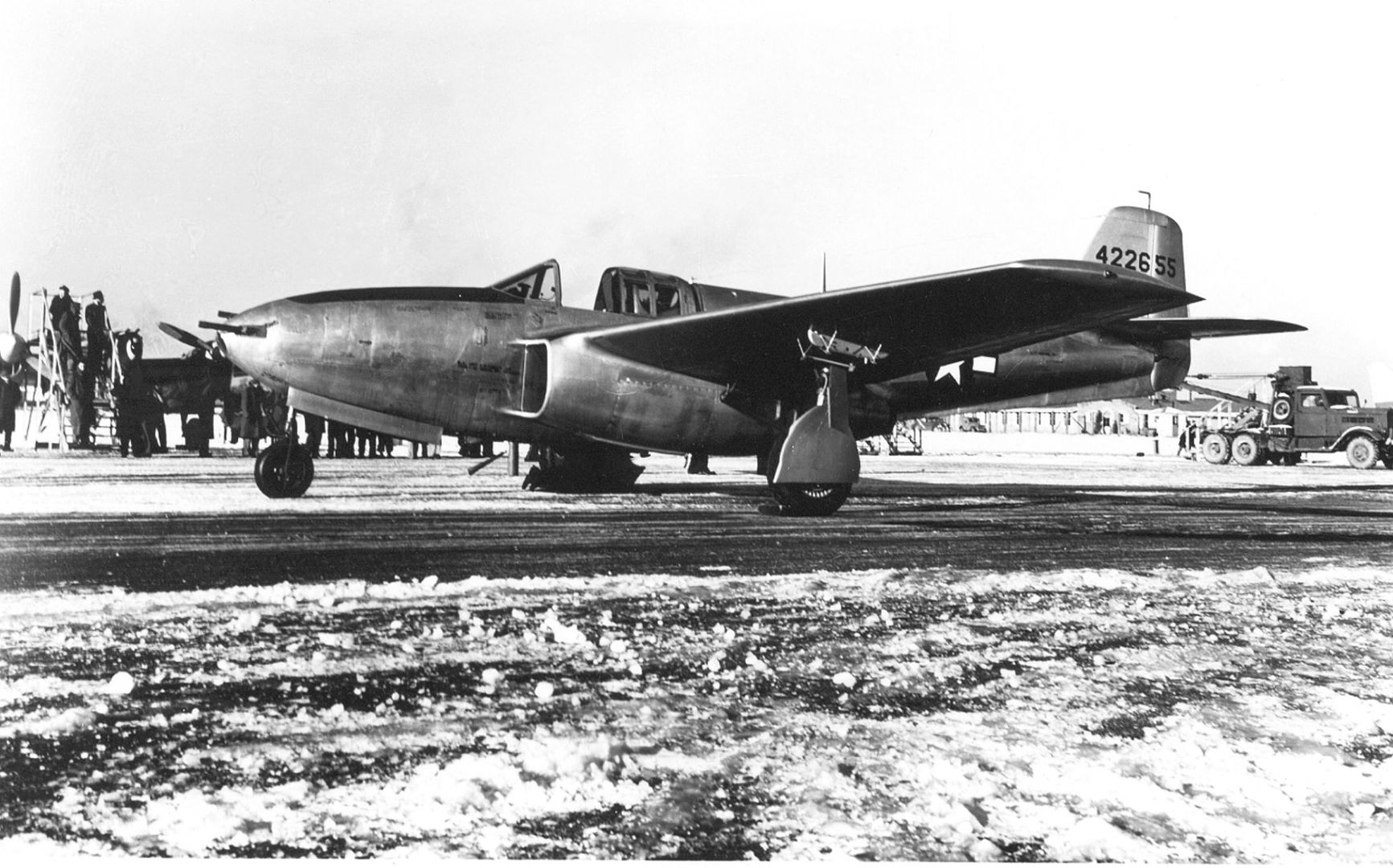

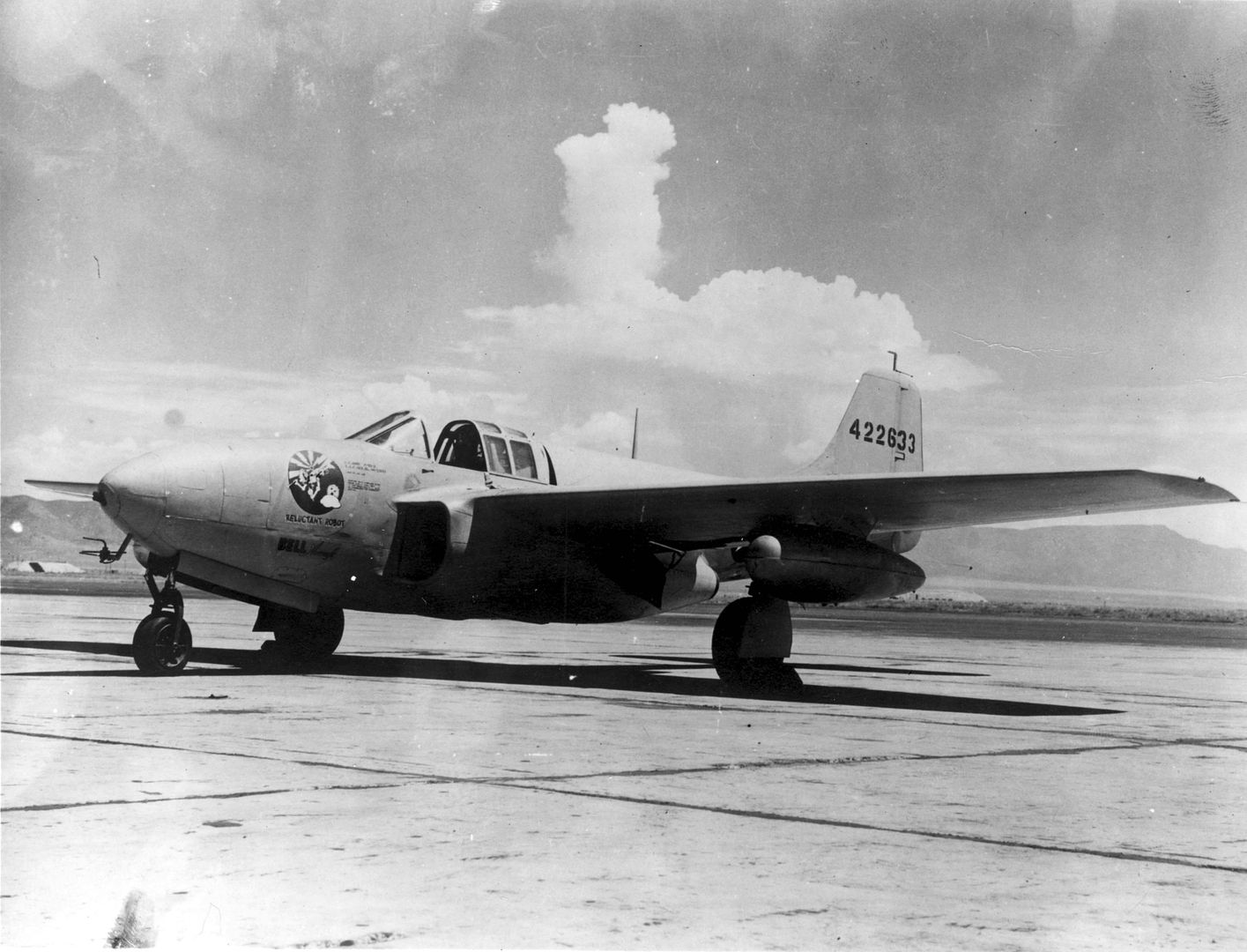
Most of the P-59s went to the 412th Fighter Group of the Fourth Air Force based at Muroc Dry Lake (later Edwards AFB), where they served in the training role. The Airacomets provided USAAF pilots and ground crews with valuable data about the difficulties and pitfalls involved in converting to jet aircraft. This information proved quite useful when more advanced jet fighters finally became available in quantity. A few P-59s were later modified and used as drone directors or manned target aircraft aircraft with a second cockpit installed forward of the main cockpit.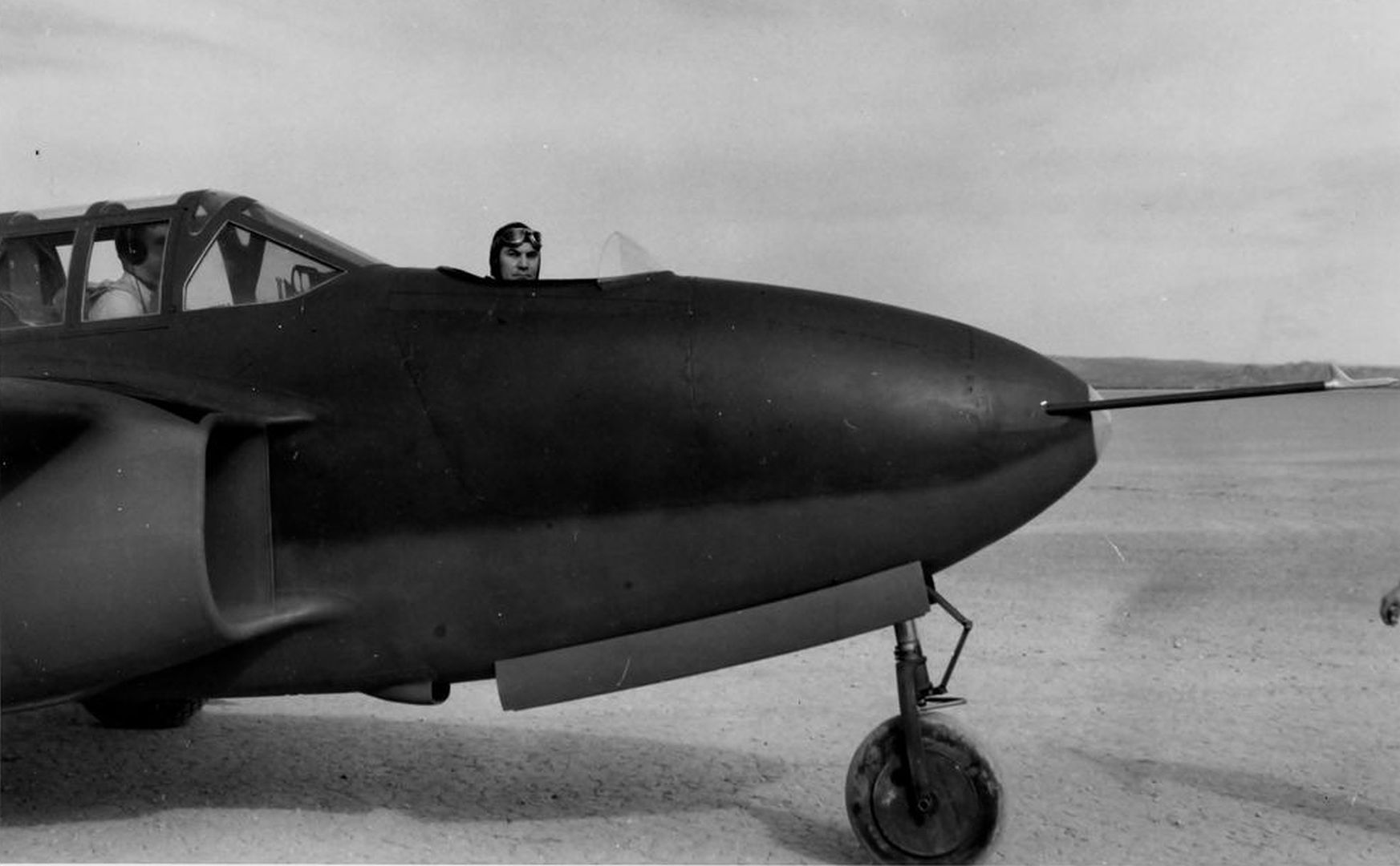
Although the Airacomet never saw service in its originally-intended role as a fighter aircraft, it nevertheless provided the USAAF with valuable orientation experience in the use of jet aircraft and furnished a nucleus of trained jet pilots.
The Airacomet was to have one other major impact on aviation history, one that is not generally recognized. Bell engineers undertook some initial work on a single-engined version of the Airacomet, which was designated XP-59B (not to be confused with the P-59B). It had a low-mounted wing and was to be powered by a single General Electric I-16 turbojet engine housed in the rear fuselage with an air inlet at the wing roots and an exhaust in the tail. However, the Buffalo plant was so busy with other projects that in late 1942 the USAAF transferred the preliminary drawings of the single-engined XP-59B to Lockheed, where it became the inspiration of the famed P-80 Shooting Star.
General characteristics
Crew: 1
Length: 38 ft 10 in (11.84 m)
Wingspan: 45 ft 6 in (13.87 m)
Height: 12 ft 4 in (3.76 m)
Wing area: 386 sq?ft (35.86 m?)
Empty weight: 8,165 lb (3,704 kg)
Loaded weight: 11,040 lb (5,008 kg)
Max. takeoff weight: 13,700 lb (6,214 kg)
Powerplant: 2 ? General Electric J31-GE-5 turbojets, 2,000 lbf (8.9 kN) each
Performance
Maximum speed: 413 mph (359 knots, 665 km/h) at 30,000 ft (9,140 m)
Cruise speed: 375 mph (326 knots, 604 km/h)
Range: 375 mi (326 nm, 604 km)
Service ceiling: 46,200 ft (14,080 m)
Climb to 30,000 ft (9,140 m): 15 min 30 s
Armament
Guns:
1x 37 mm cannon
3x .50 cal (12.7 mm) machine guns
Rockets: 8? 60 lb (30 kg) rockets
Bombs: 2,000 lb (910 kg) bombs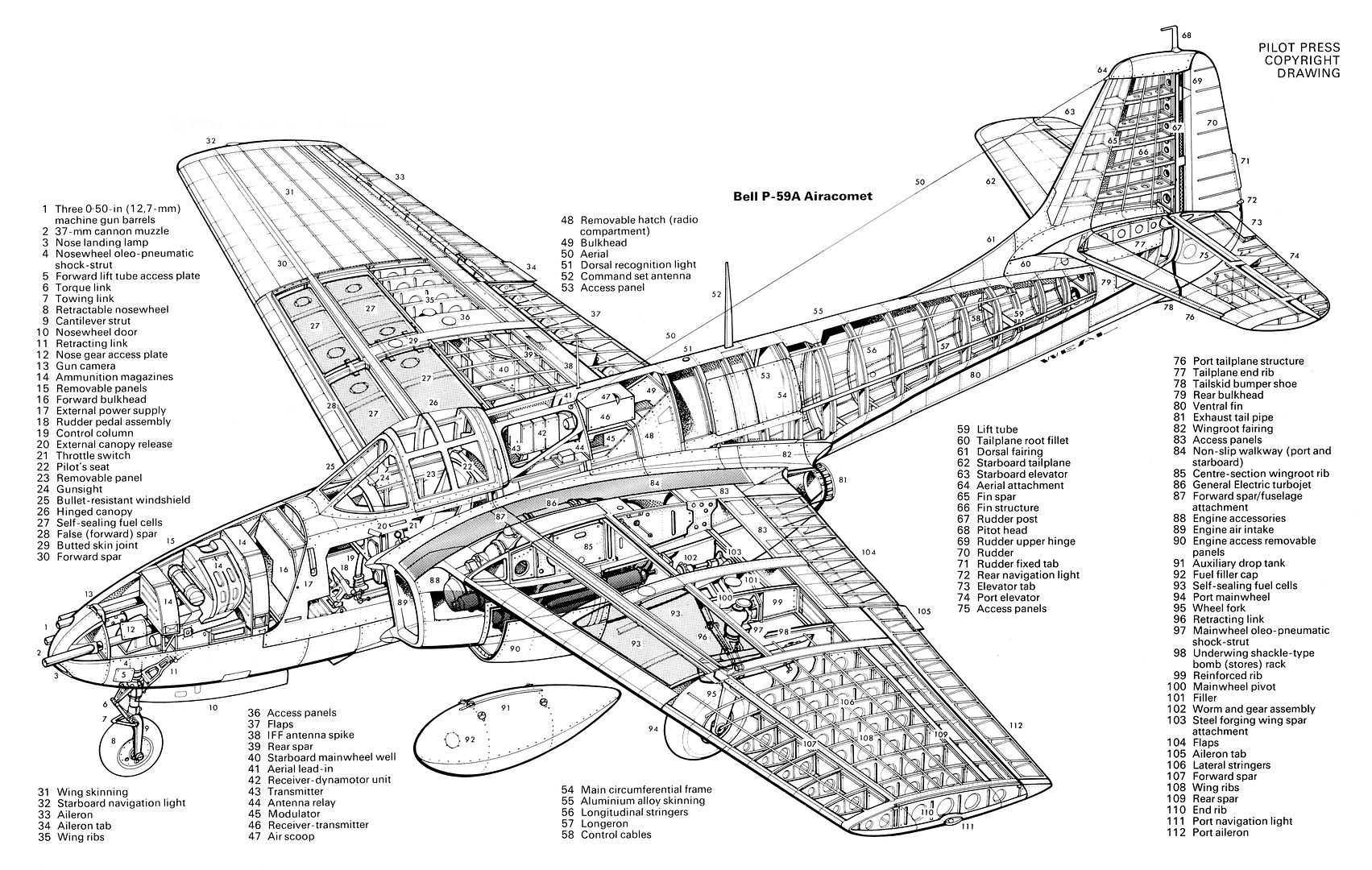
Post a reply
- Go to Previous topic
- Go to Next topic
- Go to Welcome
- Go to Introduce Yourself
- Go to General Discussion
- Go to Screenshots, Images and Videos
- Go to Off topic
- Go to Works in Progress
- Go to Skinning Tips / Tutorials
- Go to Skin Requests
- Go to IJAAF Library
- Go to Luftwaffe Library
- Go to RAF Library
- Go to USAAF / USN Library
- Go to Misc Library
- Go to The Ops Room
- Go to Made in Germany
- Go to Campaigns and Missions
- Go to Works in Progress
- Go to Juri's Air-Raid Shelter
- Go to Campaigns and Missions
- Go to Works in Progress
- Go to Skinpacks
- Go to External Projects Discussion
- Go to Books & Resources
